Ashen Stars by General Ironicus
Lasers, The Bleed, and You
Original SA post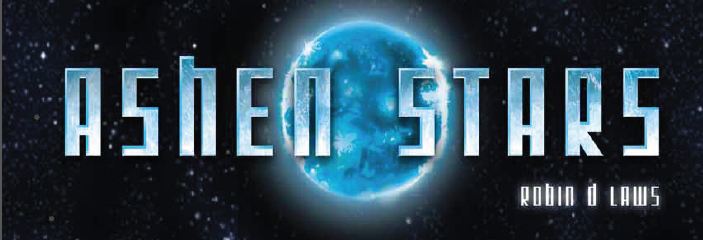
ASHEN STARS
Website
pdf on DriveThru RPG
Part 1: Lasers, The Bleed, and you
Ashen Stars is a space opera game by Robin D. Laws (Hillfolk/DramaSystem, Feng Shui, Robin's Laws of Good Gamemastering, The Dying Earth, Over the Edge, Ken and Robin Talk About Stuff ), published by Pelgrane Press, which uses the GUMSHOE engine for investigative games. You may recognize GUMSHOE from the horror investigative games The Esoterrorists, Fear Itself, Trail of Cthulhu, and Night's Black Agents, or the superpowered CSI game Mutant City Blues. Ashen Stars takes the system away from the 'present day meets the unreal' format to the stars, which may or may not happen to be ashen. It draws huge inspiration from Firefly, the grittier bits of Star Trek, the jedi-free parts of the Star Wars universe, and anything else involving people meeting aliens and solving mysteries in order to keep on trucking.
I'll be doing these writeups alongside the book's layout, generally one chapter at a time. The way information unfolds reminds me of Mouse Guard, in that it starts with the highlights about the game's mood, central activity, world, and where the player characters fit in it. If you have more concrete questions about just how it works, trust me, we'll get there before long. It's a game of utopianism vs bitter reality, altruism vs selfishness, and ray guns vs your face. Let's dive in:
Chapter 1: All the Justice Credits Can Buy
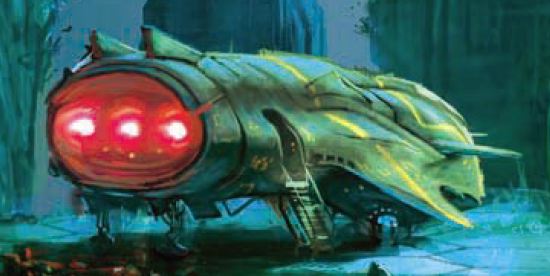
This ship goes in space. It is a spaceship.
The book proper starts with an in-universe description if the major bulletpoints of the setting and how you fit in it. You are a Laser, a freelance contractor paid to represent the law. You operate in the Bleed, a semi-autonomous frontier region of space where the Combine governemnt is weak enough to need freelance contractors to represent the law. Laser crews are known to succumb to the cash that often accompanies corruption, but bad reputations also lead to bad contracts. It's up to you to walk that line.
Not long ago things weren't so strained. The Combine is an amalgam of space empires that had dedicated itself to peaceful exploration and discovery and the Bleed was its brave new frontier. Then, a disastrous war came with the Mohilar. Nobody remembers the Mohilar clearly, and reports are often contradictory. This ill-understood psychic phenomenon is called the Bogey Conundrum. All that's for sure is they were bad news. The war crippled the Combine fleet, poisoned planets, and scarcity returned to the galactic economy with a vengeance. Now, as the Combine licks its wounds and the Bleed tries to cope, the duties of law and order have fallen to you. Lucky, lucky you.
Creating Your Character:
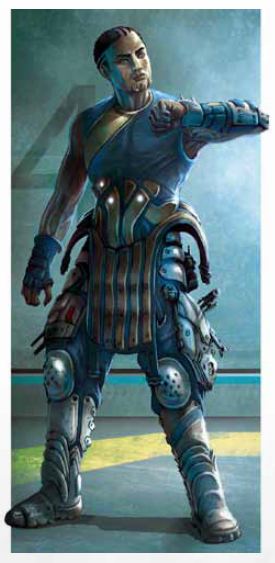
You can make this guy, or someone with fashion sense.
In order to play as a Laser, you'll need to make up a Laser. First, pick a species:
Balla : Space elves but also Vulcans
Cybes : They're cyber men, possibly also Cybermen
Durugh : Fought against the Combine not too long ago, have the ability to phase through solid objects
Humans : Completely unrelateable to me
The Kch-thk : Warrior locust people that reincarnate. These guys are fun.
Tavak : A noble warrior race with a strict ethical system, but surprisingly smooth foreheads
The Vas Mal : There was once a mighty race of near-omniscient energy beings. There is now a race of runty blue people. What's up with that?
Second, assign crew packages. Think of a package like a class. Each one comes with certain skills you'll need in your life as a Laser and determines your role. You get one for on the ship (Warpside) and one for off it (Groundside). Warpside packages are communications, pilot, strategic co-ordinator, systems, and weapons. Groundside packages are cultural, operations, survey, security, and technical. The Medical package has uses in both settings, so it's a special case where you only need the one.
At some point you should think about what your Laser did during the Mohilar war. The book places this before choosing a species, but I think it fits here just as well. There's no mechanical consideration here, but there are suggestions from the typical (serving/avoiding the war effort), rarer (just woke up from a coma and missed the whole thing), and the setting unique (was a swirling energy being untethered from limited notions of space, time and causation).
Next is choosing your investigative abilities. This is a game about solving mysteries so these are really important. This is also the first time we touch on GUMSHOE rules directly. Every section in this chapter directs you to a later chapter that deals with these things in-depth so I'll repeat myself: trust me, we'l get there before long. Character creation is meant to be done as a group, and this part is dependent on your group size. Everyone has a certain pool of points to spend, and the size of that pool depends on the size of the group. Smaller Laser crews are made of generalists and larger ones are made of specialists.
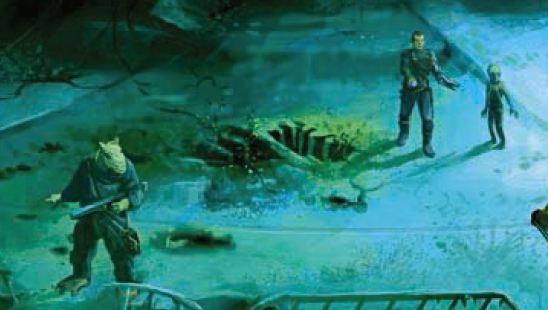
Looks like nobody bought the 'Erect Police Line' ability
Start by subtracting the cost of your crew packages from your total, that leaves the number you have to spend in this step. The GM reads down the list of investigative skills and whoever wants each one says so, and spends a point to get it. Every skill needs at least one person to have it. It's sort of like starting Risk by going around the table and everyone putting an army on a territory. Once all the skills are taken you have three options for your remaining points: hoard them and assign them during play when they become relevant, buy into an ability someone else on the crew has, or add more points to an ability to increase your proficiency in it. You can also do all of the above in some combination. They're your points, go nuts! Species' and crew packages also come with benefits to certain abilities, so you should probably get those for sure.
We'll cover the full list of abilities and why they're cool later, but here's some highlights from the list: Forensic Accounting, Cybe Culture, Linguistics, Bullshit Detector, Cop Talk, Respect, Explosive Devises, Holo Surveilance, and special Vas Mal abilities like Timesight.
Next is general abilities, which work a lot like Investigative abilities but different. They cover things like your health, ability to shoot, punch, and fly, capability with technical systems, and the other activities that keep you alive and in business. Everyone gets 75 points to spend and I reccomend putting all you can afford in my favorite ability in any game: Public Relations. Another difference between the two types of ability is what their value says. One point in Botany means you are a good enough botanist to find any core botanical clue. One point in Shooting means you often know where the trigger is on most guns. A four or five is generally competent, while an eight is more like The Spaceman With No Name. There's no cap on abilities, but your second-highest rating must be at least half the value of your highest.
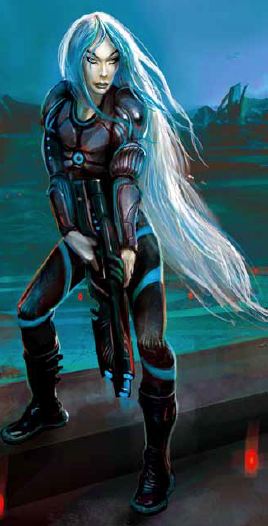
Rating of 7 in hair, 0 in smile
The next step is one of my favorite things about this game (my other favorite things are later in the chapter): choosing your drive. A Laser's drive is their motivation for being out in the bleed. The list is varied, inspires ideas, and keeps characters within space opera tropes while leaving plenty of breathing room. The drives chapter will be a fun one where we'll talk about Combinism vs Bleedism, Altruism vs Entrepreneurial drives, and how Sexual Adventure really can work in this game.
The next two steps are about your gear. First, choosing the rustbucket you'll call home; and then the enhancements you'll give it and yourselves. There's a whole array of trans-human enhancements, special-purpose gear, and modular ship parts to pick over, and Laser crews do get a budget to start out with. Cash is very important in Ashen Stars. You get it by carefully walking the line between hired thugs and noble lawmen, and without it your robot parts won't work and your ship won't fly. This is tied to the Reputation system. New Laser crews start with Reputation 0, the neutral value.
Now that you know what characters are made of, it's time to add the personal touch. Names, physical descriptions, and stuff like that are cool and necessary, but Ashen Stars asks for something better: Personal Arcs. Your personal arc is the thing your subplots are built around. They're what your 'B-plots' are made from, and when the 'A-plot' touches on them it's a chance for your Laser to shine and invest the emotional impact that can make a session really special. This section reveals how indebted the book is to TV procedurals in its language, and this example that couldn't possibly be a joke at a certain show's expense, nope:
quote:
In an episode of an imaginary TV series, the crew of the spaceship Brasilia intercede in a civil war between two seemingly indistinguishable factions of an alien species. Meanwhile, Commander B.O.R.N., in his ongoing attempt to learn what it is to be human, tries to master the subtleties of the trombone.
Arcs are essentially goals with a vague plan to get there. Here's the format for making one up, and if you never play Ashen Stars I recomend stealing it for use in the game of your choice:
1. A brief sentence or phrase expressing your character’s most important goal.
2. (Optional) A second sentence showing how this goal relates to the character’s internal conflict between altruism and selfishness.
3. A brief sentence or phrase suggesting an introductory subplot featuring your character.
4. Another subplot that builds on the idea introduced in the previous one.
5. A third subplot concept, again building on the others.
You can see how just a little bit of homework can turn any series of games into a well-developed, character-facing campaign. I love Personal Arcs. I love them so hard . Suggested themes to inspire personal arcs are the game's interest in altruism vs selfishness, conflicts between impulses and aspirations unique to each species of the Combine, or even lifting the description of your Drive. Doing one of those would leave you with a thematic goal; open-ended and reusable. Arcs can also be based on concrete goals that have a clear, achievable end; like solving a greater mystery or earning a particular accolade. Both work, and having a crew with some of each sounds like fun to me.
The rest of the chapter is fun stuff about how to implement personal arcs and subplots in a satisfying way. I'll happily answer questions about it, but it's just sound GM advice and nothing specific to the game so I don't feel a need to summarize it just yet.
Next time: The species of the Combine
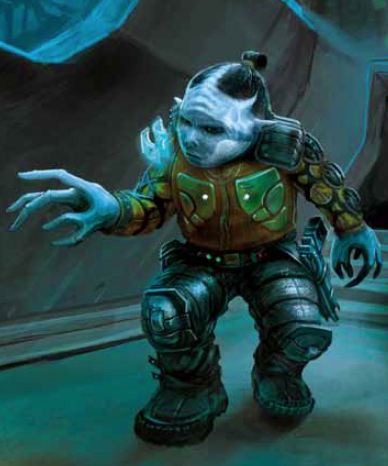
Personal Arc: Learn how to high five
Meet the Peoples
Original SA post
ASHEN STARS
Website
pdf on DriveThru RPG
Part 2: Meet the Peoples
Every space game needs nifty aliens. The Combine is made of seven major (i.e. playable) races. There are always more aliens out there, even non-humanoid ones, but they aren't in this book. The cultural details are left up to the players who choose them, outside of some broad, general facts laid out below. Even then the bok encourages you to use your table's ideas if they conflict with the presented material.
These profiles also cover species' mechanical benefits. You get 3 boosts to abilities, meaning a reduction of 1 for spends and an increase of 1 on the result of rolls. Also some cybernetic/Viroware gear is either cheaper or costlier because of your species' genetic code. Your species can also suggest a unique drive and supply a unique ability. So let's dig in:
Chapter 2: The Seven Peoples
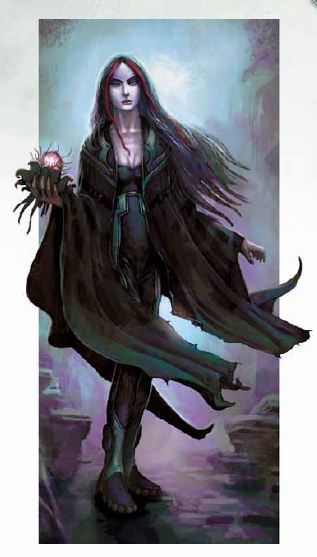
Meditation on the Space-Lotus
The Balla
Balla are known for calling the shots and a strange cultural practice where they affix knives of about 50cm in length to antelope-like creatures from their home planet.
Actually, Balla are a variety of space elf that grows more attractive as they age. This of course begins with really ugly babies, but by the time Balla are old enough to leave the planet and seek their fortune they are invariably smokin'. Elderly Balla live in isolation so they don't drive everyone who sees them mad with desire. Balla retirement homes sound like a heck of a party.
Balla are also known to have powerful emotions that they are constantly working to control and conceal. They even have a little bit of handheld tech to focus on in meditations, and losing it risks "slipping forever into a hallucinatory fog". Emotional outbursts are also contagious, like yawning, so acknowlewdging emotions at all is a major taboo.
To get back to the elf thing, they have a general cultural affinity for nature, their own ancient history, music, and speech patterns that are translated as formal and pretentious.
Balla get boosts to botany, geology, history (balla), and zoology (pick 3). Their unique drive is self-exclusion, and have the species-specific Emotion Supression ability. Their special is Inspiring Presense, a 1/episode power to refresh one of another PCs general ability pools during a calm moment.
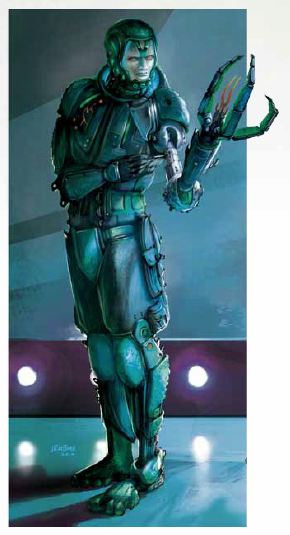
Cyber-gloves are a booming industry
The Cybes
During the Mohilar War regular human soldiers just weren't doing the trick, so Combine scientists made Cybes. Now the war has ended, and what to do with them is a hot topic. Most Cybes consider themselves a new species and want to build their own cities and culture like any other. Attempts are not yet sucessful, and there's the matter of the built-in aggression they were given during their creation as super soldiers. Still, there is hope for a rational utopia of self-improvement and self-determination.
There is also a small minority of Cybes who consider themselves human and seek integration. The rest are either somewhere between the camps, or of a completely different, idiosyncratic persuasion.
Cybes get bosts to culture (Cybe), bullshit detector, and virology. They may have the integrationist or social engineer drives. They are compatible with all cybernetic implants and viroware, as you'd imagine. They also have specific abilities called enhancement integration and neural rewiring. Neural rewiring allows Cybes to reallocate their ability points at will, but with a cost.
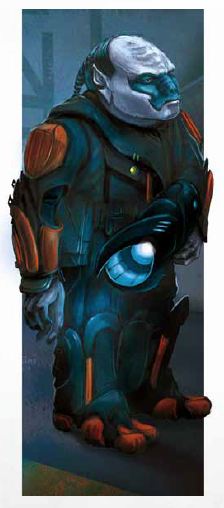
You'd be grumpy too with that harcut, outfit, stature... he has his reasons is what I'm saying
The Durugh
The Durugh were an enemy of the Combine until recently, and were actually allied with the Mohilar at the start of the war, until they learned of Mohilar plans to eliminate them and swapped sides. The Durugh like to take credit for winning the war, but thanks to the Bogey Conundrum good luck proving it. A small faction wants to go back to war with the Combine, but most Durugh appreciate the benefits of membership.
Change comes hard. The rigid caste system of the past has died and now all Durugh are able to phase through walls. Play as a Durugh if you want to phase through walls. Now all Durugh worlds are in some state of anarchy and restructuring or other, and the predjudices of old enemies face those who go to other Combine worlds.
Durugh get nine abilities to choose from for their three boosts, pretty much all the sneaky ones. Phase Rider is their unique drive, and as mentioned their unique ability is Phase.
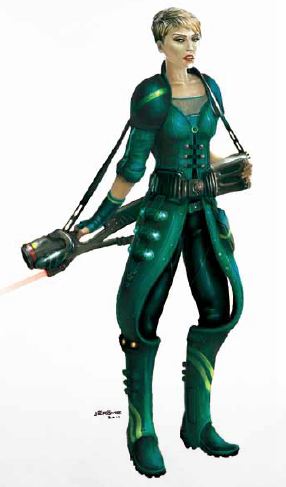
Early Wreck-It Ralph concept art? You decide.
The Humans
Humans are everywhere and are politically dominant in the Combine. Of course they may not always look like today's people, cosmentic genetic alteration was all the rage a few centuries ago and the results are still in the gene pool. Humans have a bit of a narrow view of galactic life, so when one makes a speech about the power of the "human spirit" most species have learned to just nod politely.
Humans are known for their adaptability, including the ability to believe the impossible. Sometimes it leads to tribalism and schism, and sometimes to the impossible dream the Combine was at its height and could be again.
Humans get four boosts to abilities instead of three, from a list of sixteen interpersonal and general abilities. I guess we aren't inherently academic or technical. Humans have no unique drives, abilities, or implant interactions, but they do have a special power. In any sort of contest when a pool drops to 0 you can roll a die. If it comes up 1 the pool is instantly refreshed.
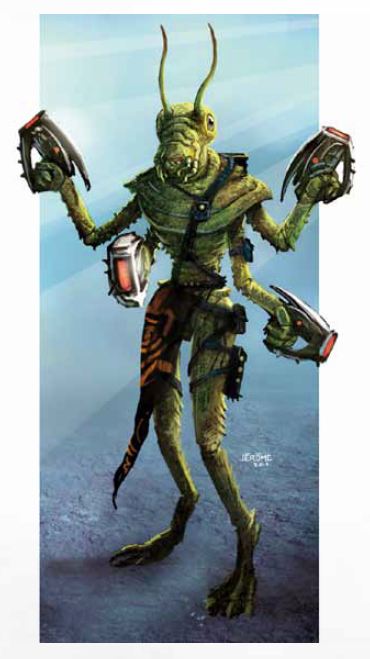
I'm here to shoot rayguns and chew bubblegum, and I don't have the necessary mouthparts to chew bubblegum
The Kch-Thk
These guys are the best. They are born in the thousands, their eggs inspected for flaws. At birth they are trained in the six deadly arts and their DNA is imprinted on less worthy larva. When they die, their consciousness migrates to one of those backup larva and they are regrown, ready to fight again.
They're good at fighting, and better at eating. The Mohilar war was a glorious time for the Kch-Thk as they were let loose to consume planets and battle the enemy. Sanctions on reproduction were lifted so great multitudes of warriors could go to the front, but now there's a population boom the Combine can't support. Kch-Thk speech is littered with references to how the creatures they meet probably taste.
They choose three of history (Kch-Thk), intimidation, scuffling, and shooting for their boosts. Their unique drive is Hunger Tourism and their specific ability is migrate consciousness.
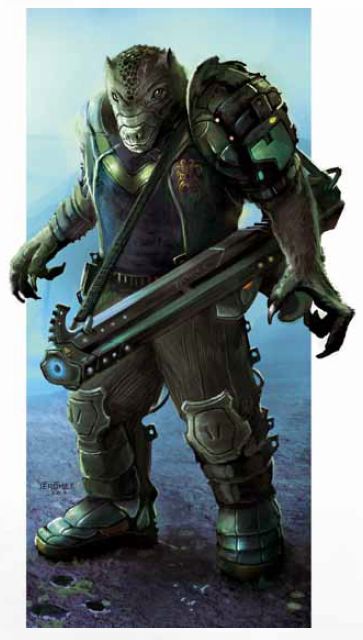
Pictured: A big softy who just wants a hug
The Tavak
Long ago the Tavak were a serene, pastoral people who instinctively sought harmony. On reaching space they discovered a need for war and a natural advantage in their thick hide and retractable claws. Tavak are now known for their ability to switch between their thoughtful, serene nature and a dedicated warrior's actions... except in the case of battle frenzy. Watch out for that.
They're generally wise people of few words. Lots of grunting helps to accentuate the words part.
In addition to the normal boosts and compatibilities, Tavak get +1 to their hit threshold and damage using claw attacks, as well as the ability to do lethal damage with a weapon tuned to a non-lethal setting at-will, requiring no spend of shooting points to switch the weapon's setting. Their unique drive is meditative reconciliation.
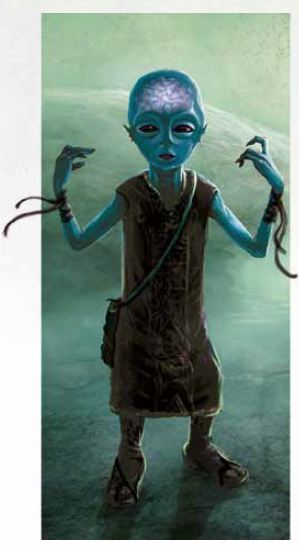
Okay, now imagine him armed to the teeth
The Vas Mal
The Vas Kra were energy beings unbound by linear time and space, perfectly joined with the cosmos. They took notice of humans and nursed them gently as they explored the universe. The Combine only came to be because of some odd coincidences and unseen connections manipulated by the Vas Kra. One cannot change a system without leaving their mark though, and the Mohilar found a way to remove the Vas Kra from the equation. Their doomsday device devolved them into the weakly and mortal Vas Mal.
Five years later the Vas Mal are a recognized part of the Combine, largely set on discovering the cure for their condition and again becoming what they once were. They have powerful psychic abilities, but using them taxes their frail bodies. Vas Mal get three boosts from a list of seven, mostly related to communication and unknown energies. Their unique drive is reevolution. Vas Mal biology clashes with every cybernetic or viroware enhancement.
Vas Mal have a selection of species-specific abilities that have some extra rules applied. Here's the list:
Consciousness Simulation
Dreamsight
Farsight
Neurosight
Timesight
Pathway Amplification
Probability Override
Psychic Vitality
Psychic Vitality is automatic, and you get up to two others of your choice free at character creation. Any of the five you passed up can be bought as well, but the first ability point will cost five build points, so be sure you really want to be a super psychic at the expense of other skills.
So that's the species profiles, but this chapter has two sidebars worth mentioning. Yhe first is Inter-Species Romance. Basically, everyone is able to be romantic with anybody else and the heart wants what it wants, no matter how many hearts you happen to have. The Tavak and Kch-Thk have parts that are not compatible with anyone else's parts, so they have to get creative. Cybes are infertile even among themselves. Vas Mal can reproduce with humans and Balla but they don't like to. Balla and Human parings can create offspring, but the pregnancy often doesn't come to term, and the children that are born just look like ugly Balla. The destruction of the war made tolerance less popular than it was in the golden age, but you never know what's going on when prying eyes aren't around.
The second is about non-standard characters. What if you don't like the seven peoples and want to be something entirely different? In that case it's your job to sell the GM on your concept. How does it reflect the game's theme? Will it make a good story? Are you just trying to get superpowers? Making a unique character is up to cooperation between the player and GM, the only hard rule is that the boots and gear affinities for your custom 'species' aren't already given to one of the existing ones (and personally, I'd happily fudge that).
Next time: your job and how to do it.
Career Day
Original SA post
ASHEN STARS
Website
pdf on DriveThru RPG
Part 3: Career Day
The third chapter is all about defining those abilities you picked during character creation. It's also really long and mostly made of lists, so I plan to tackle it in (at least) three parts. This update is all about crew packages, the loose equivalent to a character class. When making your character you and your group divided up the warpside (on-ship) assignments, the the groundside (off-ship) ones.
If your group has four or fewer people, a warpside assignment can be given to background PCs controlled by the players when they're needed, and not really present any other time. The sidebar on background PCs offers these words of wisdom "If there's a funny accent everyone in the group can do, that's how a background PC talks". If my group played this our pilot would be Krang, and that's awesome. Groundside assignments should be doubled up so the PCs do all the investigative work themselves. Now, let's take a look at the jobs:
Chapter 3: What You can Do
Warpside Assignments
Communications Officer (Hailer)
Receptionist/frontman/psychological warrior. It's your job to make sure data only goes where you want it to, and everyone knows everything they need to know. You get some interpersonal abilities and decryption for your investigations, high skill in communications intercept, and a real nose for trouble.
Pilot
You fly the ship, and with how crowded a warp corridor can be, not to mention laser fire, that's no easy task. Pilots have the skills to drive or fly anyting, and their helm control is expert.
Strategic Coordinator (Stratco)
Navy ships have captains and strict military rank. Laser crews are democratic affairs where everyone has equal say. Even so, when the going gets tough and the weapons go hot the crew looks to you to pull their asses out of it. The Stratco gets no investigative abilities, but does have well-rounded abilities for running, punching, and shooting, along with their hard-won naval tactics skills.
Systems Officer (Wrench)
Everyone else gets to stay clean on the bridge, but its your work that keeps the ship flying. It can be grimy and thankless, but nobody understands the old bird like you do. Systems officers have a working knowledge of system design as well as their high skill in repair.
Weapons Officer (Gunner)
A good Gunner works with their Stratco like a hand in a glove, just don't ask them which is which. No matter how fancy the other guy's flying is he's still right in your sights. A weapons officer gets their own share of scuffling, shooting, and sense trouble, as well as their impressive battle console skill.
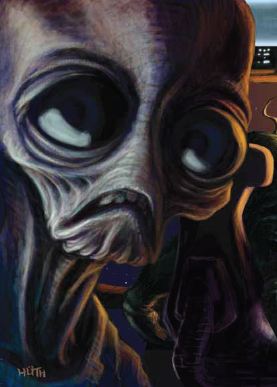
It isn't required for the medical officer to scream "We're all gonna die!" but some groups may find it helpful.
Groundside Assignments
Cultural Officer (Face)
Every Laser needs to know how to talk to people and get what you need from them, but you make it an art form. Nobody on the crew gets how people work quite like you do, and they defer to you when it's time to face the truly unusual. Cultural Officers get some interpersonal abilities along with things like history and anthropology to boot.
Operations Officer (Bagger)
Bringing law to the lawless is a business now, and seeing that through is your job. You handle the creds, the contracts, and the books. That means you also have what it takes to follow the money; always useful in an investigation. Baggers cover things like forensic accounting and bureaucracy for investigations, and have the all-important business affairs and public relations abilities.
Survey Officer (Mapper)
Space is a big place, and not as well known as it used to be. Your job is to understand the biology, geology, astronomy, and kooky alien energy signatures that often play a role in the contracts your crew will take on. In addition to all those sorts of investigative abilities, Mappers get a big heap of sense trouble.
Security Officer (Chopper)
The funny thing about criminals is they don't like to be caught. You've got what it takes to persuade them. Sometimes that's a bit of hard talk, sometimes a disruptor pistol, and sometimes the ol' knuckle sandwich.
Technical Officer (Techo)
Folks on both sides of the law have a slew of gadgets at hand and you know them backwards and forwards. Suspects can run, but they can't hide from from your surveilance.
Mixed Assignments
Medical Officer (Doc)
Lasers get it rough, and it takes people like you to hold them together until the job is done. The bad guys tend to get it rougher and the team can always use a medical examiner. You're useful in every situation, a unique part of the job. Medical Officers are equally good with spotting lies and disease, and have a strong medic ability.
Next Time: 12 pages of Investigative Abilities!
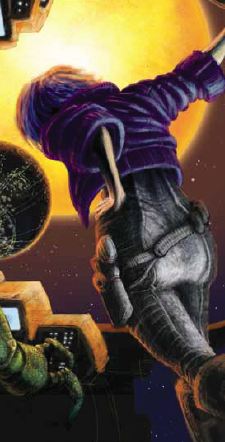
In space, no one can hear you scream about male gaze.
Clues can run, but they cannot hide
Original SA post
ASHEN STARS
Website
pdf on DriveThru RPG
Part 4: Clues can run, but they cannot hide
The meat of this investigative game is the investigative abilities, and here they are. Remember, a Laser crew from the point of character generation will have all of the following abilities covered by at least one member. Anybody can make a living one way or another in the Bleed, but your mastery of these techniques sets you apart as a Laser. Time for the list:
Chapter 3: What You can Do (part 2)
Anthropology (Academic): You know about the customs and culture of every well-documented people, and can extrapolate from that to cover the rest pretty well. You can even predict how outside stimuli will likely impact social development.
Archaeology (Academic): You know all about uncovering, preserving, and identifying artifacts left through the ages. When its time to chart a path through an ancient tomb or tell the genuine article from a fake, you're the guy. Your skill with written documents is in new demand where technology has come in short supply.
Astronomy (Technical): Interpreting star maps is a good skill to have when making a living in space. You can plot courses, guess where other ships' courses will lead, call someone's bluff on a forged itinerary, and all that cool stuff.
Bio Signatures (Technical): You can use scanning tech to find lifeforms and learn useful information about them from afar.
Botany (Academic): You get plants. Be one with the green mother and identify poisins, genetic modifications, planet of origin, and forage for foliage.
Bullshit Detector (Interpersonal): Nobody pulls the wool over your eyes (noncorporeal entities, psychic projections, and robots not necessarily included).
Bureaucracy (Interpersonal): Every world is different, but every government official is the same. You can get the documents, cut the red tape, find the whistleblower, and translate the legalese it takes to get the info you need.
Chemistry (Technical): All that lab analysis stuff you've seen on TV? That's your job.
Consciousness Simulation (Special - Vas Mal): This is the first of the Vas Mal abilities we're seeing. When sentient beings die, their brainwave signature lingers for a bit. You are able to spend 3 points to enter a trance where you see and hear a recreation of the deceased as they saw themselves. It will answer any question you ask, but each question requires an additional spend of one point. It behaves as it would have in life, so be careful and polite. While communicating you can also use other interpersonal abilities to navigate the conversation.
Cop Talk (Interpersonal): Like bureaucrats, all cops are the same and you know the drill. You have the ability to connect with them as peers to gain information, support, and to have them overlook some of your methods.
Cybe Culture (Academic): Cybes seeking to build their own society is big news and you have your finger on the pulse. You can translate Cybe slang, identify an individual's beliefs and affiliation, guess their past occupation and enhancements, and establish rapport with a Cybe (much like Cop Talk). Any non-Cybe with this should explain why they have such in-depth knowledge.
Data Retrieval (Technical): Break through the firewall. Zoom, enhance. Isolate the audio.
Decryption (Technical): Analog codes and cyphers, as well as digital scrambles and fractal encryption buckle before you, given time and computing power. Creating codes of your own is also an option. The skills involved also give you the ability to triangulate a transmission's origin, isolate fakery in a transmission, and all that fun stuff. It should probably be paired with Communications Intercept (that's next update).

I think clues are like catnip to the Balla. (Elfnip?)
Dreamsight (Special - Vas Mal): Just what it says, you can peek on dreams. The sleeper is aware of you if they become lucid (Difficulty 6 Sense Trouble test, or if the GM finds it dramatically appropriate) You can see what they see, though you cannot influence the dreamscape. On waking the sleeper may mate a difficulty 4 Sense Trouble test to know their dreams were peeped, and on a result of 8+ they know who did it. Kch-Thk do not dream and are therefore immune to this ability.
Downside (Interpersonal): The end of the Combine's golden age of prosperity and law gave rise to a new criminal underground. They are known as the 'downside'. You speak their language and can even pass as one of them. No matter what they say you don't actually have to tell them if you're a cop.
Energy Signatures (Technical): A Lot like Bio Signatures, but without the "Bio" part. Is the enemy vessel charging its weapons? damaged? full of robots? loaded with illegal tech? You tell me.
Evidence Collection (Technical): The name seems humdrum, but this covers a lot of nifty skills like discovering hidden trace evidence, extrapolating a sequence of events by the spatial relationships of evidence, and recognizing tampering or inept work by other investigators.
Explosive Devices (Technical): Red wire or blue wire, you make the call. You can also learn about bombs from their exploded remains and build your own.
Flattery (Interpersonal): A knack for sweet talk.
Flirting (Interpersonal): A knack for sweetie talk.
Forensic Accounting (Academic): Often, crimes are motivated by the almighty bigcred. You can tell the health of a company from its records or even just seeing it in action, and also find evidence of malfeasance. You can also use this ability to cook some books yourself.
Forensic Anthropology (Technical): You're the autopsy guy. Also DNA analysis, and the ability to reconstruct how deaths occurred from the arrangement of wounds, similar to Evidence Collection.
Forensic Engineering (Technical): Your knowledge of mechanics gives you the ability to identify damage and sabotage and learn about them. Actually fixing things falls under Systems Rapair (next update).
Forensic Psychology (Academic): The magic of criminal profiling is in your hands. Your skill with knowing what motivates individuals and why even extends to unknown species in a limited capacity.
Geology (Academic): You can analyze soil samples and other various minerals. yaaaaaaay.
History (Academic): History is actually six different skills, one for each of the peoples that has a history longer than a generation, plus one for the Combine as a whole, but I'm rolling them into a single entry here. They all provide the ability to understand obscure references, recall significant figures, provide context for artifacts, and all that historical stuff. Each also has a specific reference to their focus and the Kch-Thk entry proves their superiority again:
quote:
can recite the chittering proverbs of the great texts of rational materialist poetry, such as Krktl’s The Errors Of Sentimentality and Trk-chk’s Sublime Hierarchy of Foodstuffs
Holo Surveillance (Technical): You have the technical know-how to use holographic surveillance recorders and analyze their playback. More primitive technologies are available and within your skillset, but come on, holograms .
Imaging (Technical): Like Holo Surveillance, but for non-surreptitious imaging devices. You aren't just a shutterbug, your images are loaded with information suited for high-grade analysis. A properly captured image is admissible evidence, which puts it above fingerprints or even DNA with how far forging technology has developed.
Impersonate (Interpersonal): Sometimes you just want to be somebody else. Long-term cons are difficult enough to require ongoing spends, but a quick job is easier to pull off.
Industrial Design (Technical): Your knowledge of design lets you identify the make and model of most anything, reliably guess the layout of unfamiliar places, and even guess the technical capabilities of an unknown people from a few example devices.
Inspiration (Interpersonal): People tell you things by appealing to their better selves. This was an oversight in earlier GUMSHOE games that was added to Ashen Stars after Robin D Laws watched FRINGE and realized you couldn't really make Olivia Dunham in his investigative procedural system.
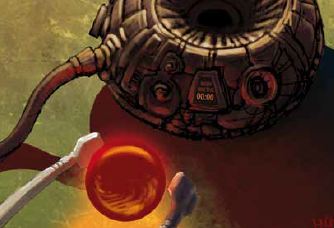
Operation isn't just a boardgame, its a far-future bomb squad training tool
Interrogation (Interpersonal): Use your authority as the law and the intimidating ambiance of a concrete cell to get what you're after.
Intimidation (Interpersonal): It's intimidation. Not sure what to say that isn't clear from the name.
Kinetics (Technical): Ballistics, but generalized to the wide array of space guns found in the Bleed.
Law (Academic): You intimately know the Combine laws you are contracted to represent, and have the ability to unravel the local laws that have sprung up on planets all through the Bleed. A rating of 2 or more means you are licensed to practice law in the Combine.
Linguistics (Academic): Translation devices are ever-present, but your studies let you go deeper. You can understand unknown languages if you have a suitable sample text and can even add it to your translators.
Negotiation (Interpersonal): Let's make a deal.
Neurosight (Special - Vas Mal): You can see people's auras and learn various things from them, depending on how many points you spend. It can work as a mood ring, a medical barometer, can if someone's been psychically influenced, or other such uses at the GM's discretion.
Reassurance (Interpersonal): Nobody is very helpful when they're stressed out in a crisis. You can bring people down so they will help you out.
Respect (Interpersonal): Those who think they have power over you will want to continue to believe so. You give proper deference and smooth over the rough patches that often come with Laser contracts.
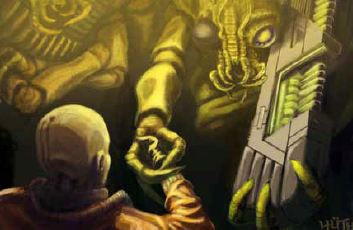
That thing looks dangerous, but knowing the Kch-Thk it probably shoots ketchup or something
Timesight (Special - Vas Mal): You still retain a shadow of your past Vas Kra ability to see non-linear time. For each point you spend the GM describes a detail related to a core clue you will soon discover, or one revealing unknown facts about a clue already found. This ability can only be used once per episode.
Vas Mal Culture (Academic): See Cybe Culture above.
Virology (Technical): Bodily transformation via engineered viruses has become a common practice. You can identify these alterations and their designers, reverse-engineer a virus from a tissue sample of someone who used it, and determine if one has been altered into a contagion. The Viro Engineer general ability lets you do things beyond gaining information.
Xenoculture (Academic): You have studied the various intelligent species the Combine has contacted outside the Seven Peoples and have command of the relevant details.
Zoology (Academic): Your knowledge of animals lets you identify animal attacks, track specimens from evidence, extrapolate the size, behavior, and other information about a creature from basic facts, and tell whether animals have undergone modification from tissue samples or observing their behavior.
Basically, that covers every way there is to gain information out in the Bleed. GMs are free to make their own investigative abilities if they see an oversight, so long as they also increase the number of build points so everything is covered.
Next Time: Abilities beyond collecting facts
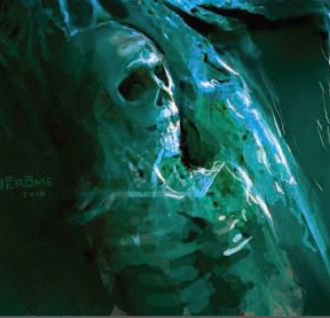
My 'Not Being an Idiot' ability is telling me this guy didn't make it.
Thirty-one ways to be awesome
Original SA postRobotic Folksinger posted:
Um, I believe you left out the all important forensic accounting ability?

Also, I need better friends to play this with.
Thanks for the catch. It's been edited into its proper, alphabetical place. Forensic Accounting is good stuff.

ASHEN STARS
Website
pdf on DriveThru RPG
Part 5: Thirty-One ways to be awesome
Today we finish off Chapter 3 with another load of lists. By now it should be clear I'm mostly splitting it for how great the chapter title is. Every book should have a section called "What You Can Do". Today's list is General Abilities, which govern everything aside from gathering clues. There are some grey areas where something could be covered by a general or an investigative ability, but the question is whether you're doing it to seek a clue to the mystery or for another purpose. Some abilities have more in-depth mechanical explanations later, space combat for instance, but some of these skills will have descriptions of game mechanics attached. Once more unto the breach:
Chapter 3: What You can Do (part 3)
Athletics: The catch-all ability for physical exertions not covered by more specific things. Lasers whos Athletics is 8+ have a hit threshold of 4, while the rest have a hit threshold of 3.
Battle Console: The ability to shoot your ship's weapon arrays. More on that later.
Business Affairs: This is used to land your crew's new contracts and arrange side deals. Those are pretty cool mechanics to be described at a later date.
Communications Intercept: The general counterpart to Decryption, it's also a valuable tactic in ship combat.
Emotion Suppression (Balla): When your Balla PC encounters an emotional stimulus, the GM may ask you to make an Emotion Suppression test to keep your cool. There's an associated chart with difficulties ranging from suffering an insult to witnessing the death of a close friend. Difficulties increase by 1 if your personal arc is involved. Failure either leads the PC to take a self-destructive action, or to reduce their hit threshold by 1 and increase the difficulty of all general tests by 1 for the next two intervals.
Enhancement Integration (Cybe): This ability allows Cybes to avoid the consequences of failing to pay the upkeep on their cybernetic enhancements, and even to make use of enhancements that are offline with some effort.
Farsight (Vas Mal): You can separate your consciousness from your physical self to take a look at faraway places. There's a chart of difficulties based on distances ranging from 55m or less, to anywhere in known space. Psychic entities may sense you watching them, and if anyone uses Farsight on you, you will be able to sense them as well.
Filch: The sticky fingers/slight-of-hand ability.
Ground Craft: Not just the ability to drive, but the skill to pull of driving stunts and dramatic chases. Ground Craft include cars, jetbikes, hover skiffs, and anything else like that.
Health: Your Health pool is basically your HP. How that is reduced and how that effects you will be covered later.
Helm Control: The Starship piloting skill. It's used in ship combat, as well as navigating tight spaces in space.
Infiltration: You can sneak up on people, get around security, and open locks. Getting in (or out) when someone doesn't want you to is a special talent of yours.
Medic: The ability to help people feel better and refill their Health pool. Specifics are in a later chapter.
Migrate Consciousness (Kch-Thk): This is what you use to migrate your consciousness to a new body on your death. Successfully imprinting yourself on one of your backup bodies is a difficulty 4 test, +2 for every time you've done it in the series (campaign). If the margin of success is thin you pick up a behavioral tic for anywhere between the rest of the episode, to the rest of your life. The Kch-Thk player and the GM work together to determine the tic ,and suggestions range from distinctive speech patterns, to changing your drive, to having a strong new personality trait.
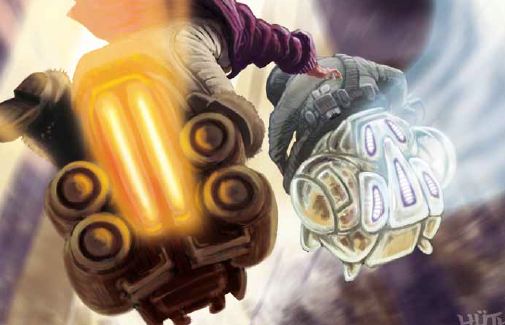
So far, there has been more art of jetbikes than starships. I approve.
Naval Tactics: Another dogfight ability, this one represents your Stratco's tactical skill. It can be used to make attacks, or to buy re-rolls for other crew members, or to fill your allies pools from your Naval Tactics pool one-for-one.
Neural Rewiring (Cybe): You can reshape your brain to recreate the thought patterns of historical experts. That means spending Neural Rewiring points to make spends for investigative Abilities you don't have. The cost is the cost of the investigative spend +1. The Investigative Abilities all belong to one of five past experts, and channeling them also brings an Emotional State your Cybe will exhibit for two intervals.
Pathway Amplification (Vas Mal): You can help your friends think. Once per episode you can pick another PC and an investigative ability they have. Your Pathway Amplification pool is added to their pool for that ability.
Phase (Durugh): The big reason to play a Durugh is for this very sneaky ability. You can walk through a solid object less than 10cm thick just by spending a point. Thicker barriers require a rolled test with difficulty increasing with the thickness. Anti-phase technology exists, and will increase the difficulty by 1-10 points. It's very expensive though, and if you encounter it you know you've found something suspicious. You can phase through with a certain amount of gear, but not with other people.
Preparedness: Rather than detailing every small bit of equipment, Preparedness allows you to simply have things when you need them.
Probability Override (Vas Mal): Your former mastery over destinies is now the ability to nudge local probabilities. If a character fails a general ability test you can spend 4 Probability Override points to give them a re-roll. If they succeed the second time the characters see the failure, then a quick time rewind before the success happens.
Psychic Vitality (Vas Mal): Every use of a Vas Mal special ability severely weakens them for a period of time, unless they make a successful Psychic Vitality test. The difficulty is either 4 or the number of points you spent on the special ability, whichever is higher. Failing loses you 3 health as well as making spends more costly and reducing your hit threshold.
Public Relations: My favorite! Your job isn't to solve mysteries, your job is to get contracts and complete them for money. It's an important distinction and Public Relations bridges the gap. Later we'll talk about the Reputation system and how exactly this works in play.
Resist Battle Frenzy (Tavak): Similar to Ballas' Emotion Suppression, when a Tavak sees a comrade seriously harmed they must make a test to not go into battle frenzy. Failing the test gives you regenerating health, a lower Hit Threshold, all attacks become lethal, and attacks have a chance to miss their target and hit someone else. The entry ends with a note on Tavak culture:
quote:
Although it originates in a genetic alteration your ancestors engineered into the species in the late 22nd century, honorable Tavak are obligated to describe this impulse as ancient and atavistic.
Scuffling: The hand to hand combat ability.
Sense Trouble: You've got a bad feeling about this. This ability gets you information, but its for information regarding impending doom, not the mystery plot. GMs generally tel the players what the difficulty is for a test, but for Sense Trouble the spends are always blind.
Shooting: This covers any sort of ranged weaponry. It's pretty handy to have, considering you're called a Laser for a reason.
Shuttle Craft: This ability covers sub-orbital vessels. It's the transitional ability between Ground Craft and Helm Control.
Surveillance: You are able to see without being seen. This covers things like stake-outs, tailing someone, and all that good detective stuff.
Systems Design: You are able to fabricate new devices.
Systems Repair: You can maintain existing devices. This is very important in ship combat.
Viro Manipulation: Viroware is a powerful and volatile tool in the Combine. You can alter, engineer, and relieve the symptoms of any viroware that's causing problems.
Next time: We shift into drives
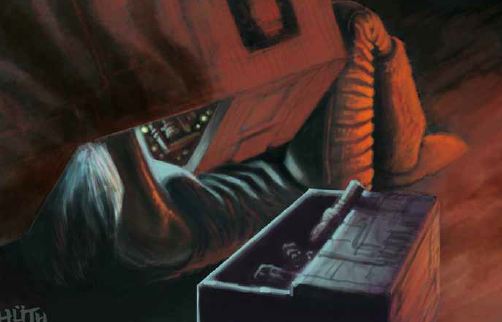
I know I left that core clue in here somewhere...
Over Drives
Original SA post
ASHEN STARS
Website
pdf on DriveThru RPG
Part 6: Over Drives
Drives are the emotional motivating factor for a Laser's actions. It's the reason they stick their neck out and what keeps them hunting for a new contract after the last one's finished. While GUMSHOE is still a procedural game, the Drives can be seen as a precursor to the emotional interactions that make up Laws' DramaSystem.
Drives are also supposed to compel characters to act when players are feeling cautious. Space Opera protagonists are meant to leap into danger with a swagger and gritted teeth, or at least a quick hesitation before diving in anyway. If your players would rather poke everything with a 10 foot pole from behind cover, ask them how their character's drive would motivate them to act. In extreme cases a GM can assess a stress penalty to spends and difficulties until a character begins acting more in line with their Drive.
Anyhow, this is yet another list chapter. The one after this isn't, so take heart. Drive Time:
Chapter 4: Drives
Altrusim: With the Combine on its knees the need for good people to act for the benefit of others is greater than ever.
Atonement: You can only erase your terrible wrong by improving the world at every opportunity. This might be a matter of conscience, repentance, or an extreme Community Service sentence. Slowly revealing the nature of your past wrong is an automatically cool Personal Arc.
Avenger: Someone close to you was destroyed by the lawless and you're out for revenge. Maybe you got your vengeance on the specific culprits, and maybe not, but your crusade is now against all lawbreakers. You are space Batman. Hunting for your space Joe Chill is another ready-made personal arc.
Bleedism: The Combine is over and it ain't coming back. You're out to create a new Federation; by, of, and for the Bleed. You're providing local solutions to local problems, and when the Bleed stands on its own your efforts will be rewarded.
Civilizer: The Mohilar war wrecked planets, cities, economies, and everything else. Your work as a Laser is meant to rebuild the bonds of society so new glittering cities can rise, and new art can flourish, and everything can go back to how it was.
Chronicler: As a writer you need a wide variety of life experience to draw from, and nobody has more of that than a Laser. Whether you intend to write the great history of the Bleed, or a blockbuster serial holonovel about dashing heroes, your magnum opus will have the unique stamp of life as a Laser.
Combinism: By reducing the lawlessness and chaos in the Bleed you are paving the way for re-assimilation into the reborn Combine. You probably used to have, or would like to have, a commission in the Combine fleet. You don't get along very well with Bleedism, but individual Bleedists may not be so bad.
Comradeship: Whatever your initial motivation was, now that you've been working the Bleed you see yourself as a band of brothers. Your ship is your home and the other Lasers your family. You value loyalty above all else.
Derring-Do: You go where the action is. An adrenaline junkie hotshot is a surprisingly useful person when things get hairy.
Entrepreneurial: There's cash to be made out there, and you're sure Laser work is how to find it. What better way to make contacts on a hundred worlds and pile up favors to collect on later could there be? There's not a lot of income in it now, but a ship with a good enough reputation can grow into something more, the sky's the limit.
Exploration: Before the war the Combine endeavored to explore strange new worlds, to seek out new life and new civilizations, and all that stuff. Even now that's still in your veins, and the Bleed has plenty of dark corners left to see.
Faith: You are dedicated to your religion and advance its creed by your actions as a Laser. This doesn't mean setting up a soapbox on every planet, but that you let your actions demonstrate the truth of your faith.
Family Tradition: You come from a line of Combine fleet officers. Somehow you fell out of the regular military, but slumming around on a Laser crew still beats civilian life.
Footloose: The vast reaches of space are hardly big enough for you. Every landfall you make leaves you anxious to leave for the next one. Maybe one day you can lift the ban on teenage dancing.
Hotshot: You were born gifted and love the chances Laser work gives you to show it off.
Hunger Tourism (Kch-Thk): Your eternal hunger to feed is balanced by a desire for new flavors. Flying around the Bleed lets you sample all sorts of new organic matter. Here's another direct quote about why Kch-Thk are the best:
quote:
You probably keep a journal of your gustatory adventures, which you periodically beam to kch-thk communications network. These are enthusiastically devoured by envious readers, who yearn for news of unfamiliar ingredients.
Integrationist (Cybe): You're one of the few Cybes that seek a place for your people among humanity. The super-soldier enhancements you were created with are a natural fit for Laser work, and you hope to demonstrate that your similarities are stronger than your differences.
Justice-Seeker: Without the law the powerful do what they will and the innocent wait to be exploited. You take it upon yourself to enact not only the law, but true justice in the Bleed.
Meditative Reconciliation (Tavak): While all Tavak pursue inner peace, you go much farther, practicing a meditation known as Gahud, the three-step staircase. The first step explored the self. The second step is about the outside world, and pushes you to test yourself by experiencing physical extremes, interacting with those greatly unlike you, and working positive change in the world. Laser work is a natural fit. In your old age you will take the third step, integrating the inner and outer world, living for perhaps thousands of years in a deep coma. The earliest practitioners of Gahud remain sleeping on the Tavak homeworld, the only people able to live in its poisoned atmosphere.
Nowhere Else to Go: The name says it all. You washed out of everything you've tried and everywhere you've been. You're dedicated to the job at hand, because if this doesn't work out, what could possibly be left?
Phase Rider (Durugh): All Durugh can phase through solid objects, but about 3% have a genetic anomaly that makes phasing under stress cause ecstatic psychedelic visions. Maybe you see them as part of a nufaith religious practice, or a source of prophecy, or you just want to see the show.
Professionalism: You take Lasering seriously because it's your job, and you take pride in a job well done.
Pursued: Someone's after you, and your job is a means to stay one step ahead. You commit yourself to your work and your team so that when your past catches up to you, you'll have a crew of experts on your side. This is another ready-made personal arc.
Programming: Somebody poked around in your head to make the perfect investigator. You brave danger and solve mysteries because your deepest instincts compel you to. You may or may not be aware of the modification, and either way could suggest its own personal arc.
Re-evoluiton (Vas Mal): The limited form of your abilities still available to you says the secrets of re-evolution are somewhere in the Bleed and will be found by a Laser crew working on a seemingly unrelated case. You joined up in order to make the prophecy come true.
Role Model: Kids these days haven't got anybody to look up to, at least not the kids where you come from. You seek to break down the barriers and show there is a future for your small, derided, or oppressed group as the leaders of tomorrow.
Scientific Inquiry: Laser contracts often revolve around strange phenomena and unknown technologies. Your laboratory is out there in the Bleed and it's waiting.
Self-Exclusion (Balla): When a Balla cannot control their emotional outbursts it becomes contagious, destabilizing whole communities. That happened to you, and you have been exiled among aliens to prevent it happening again.
Sexual Adventure: Everybody looks good in a uniform and that's a fun position to be in. You have the chance to have a girl in every port, and no chance to get bogged down with attachment.
Social Engineer (Cybe): The Cybes are a new people seeking a new culture. You seek out many various societies to study them and synthesize an ideal model upon which the new Cybe worlds will grow and flourish. Laser crews are exposed to many such societies, and more importantly the ills they give rise to.
Something to Prove: For some reason or other you've been written off all your life. Nobody gives you respect, or at least not the person you most want it from. Now you work twice as hard in the face of certain danger in the Bleed to prove they were wrong about you.
Tech Hound: You love taking apart and rebuilding systems, and you never love it more than when under fire and everyone's counting on your work. The work rebuilding the Combine is more stable and lucrative, but where's the challenge in that?
Next Time: The actual rules, finally
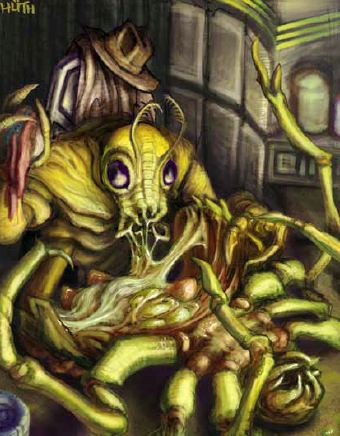
This Kch-Thk has the houseruled drive, Fashion Maven
How to play the damn game already
Original SA post
ASHEN STARS
Website
pdf on DriveThru RPG
Part 7: How to play the damn game already
It's time for the chapter you may or may not have been waiting for! I could just link you here but that would be cheating. We're doing this properly, and there's game-specific detail to discuss. There are three very important things to remember about GUMSHOE rules. The first is that they're above all emulationist . Nights Black Agents has variant rules for four sub-genres of spy thriller, for crying out loud. Ashen Stars is all about being space opera television, specifically the gritty modern reboot of a 60s-era show that never existed. If you ever hit a roadblock or confusion just try to think of how things would happen in a show like that. The third very important thing is that every die roll is 1d6. The second very important thing waits below:
Chapter 6: GUMSHOE Rules
The central premise, innovation, and conceit of GUMSHOE is that as an investigation game whenever a core clue is present, and someone on the team has the ability necessary to discover it, they do so. No roll, no spend, and no chance of failure. The question is not whether they find the information, but what they do with it. Hatching a plan to bring space-Moriarty to justice is more interesting, fun, and dynamic than trying to figure out what he's up to and the dice saying you don't. This excerpt explains the idea pretty well:
quote:
You don’t see this because, in a story, failure to gain information is rarely more interesting than getting it. New information opens up new narrative possibilities, new choices and actions for the characters. Failure to get information is a null result that takes you nowhere.
In a fictional procedural, whether it’s a mystery novel or an episode of a cop show, the emphasis isn’t on finding the clues in the first place. When it really matters, you may get a paragraph telling you how difficult the search was, or a montage of a CSI team tossing an apartment. But the action really starts after the clues are gathered.
Players stil have to take some initiative. Walking into a room, demanding a clue, and walking out is no fun for anybody. to gather a clue you must: 1) get yourself into a scene where relevant information can be gathered and 2) have the right ability to discover the clue and 3) tell the GM that you’re using it. The request can be specific or vague, but must be made. Some things (passive clues) are obvious to skilled investigators and are revealed immediately. If there are bloodstains on the carpet, then Annie is not okay and the GM should say so unprompted. The passive/active division is a continuum that depends on the situation and group. Withholding passive clues or immediately giving active ones can help moderate a session's pace or pick up a group that's having a rough night. In any case the clue goes to the character most adept at finding whatever it is, measured by their current pool in the relevant ability, or else someone in need of a bit of spotlight.
So what are numbers greater than 1 for? Spends! You can spend points from your pool to get hidden, supporting clues, or to get clues in a more advantageous way. Being able to intimidate an NPC will get you his info, but spending Reassurance can get you the clue and an ally to boot. Generally if you want to get a clue better or faster, or declare a new fact about the story, a spend of one or two points will do the trick. Players are even encouraged to suggest their own extra benefits, though the decision lies with the GM. Spends can also represent an expenditure of effort, even when there's no chance of failure. This works for general abilities too. Think maintaining a surveillance operation or scaling a cliff.
General abilities aren't always automatic like investigative ones. When an outcome is in doubt you make a test. Tests should be reserved for dramatically important moments when failure can also be interesting, but a good episode should have plenty of those anyhow. A simple test is used when there's no active resistance. The GM sets a difficulty between 2 and 8 (it's 4 more often than not) and the player rolls a die. Matching or exceeding difficulty is a success. Before the roll you can spend any number of points in your ability pool and add them to the roll, but don't forget to do it before the die hits the table or it doesn't count you big cheater. The Difficulty shouldn't be directly revealed, but instead woven into the description of the situation. It's more fun that way. "If you decide to reveal numbers, and the designer finds out that you’re doing it, he might well tease you about it."
Important GUMSHOE note: In Ashen Stars you can make tests in abilities you don't have. There's also the Lucky Shot mechanic, where once per episode a character can spend up to 4 points from one pool on a test for an ability where they're rated 0. This requires unanimous consent from all the players, because it's once per episode, not once per episode per player. On a success, the player is also required to describe how their victory was a fluke, or due to background influence from the Laser with the highest rating in the ability used.
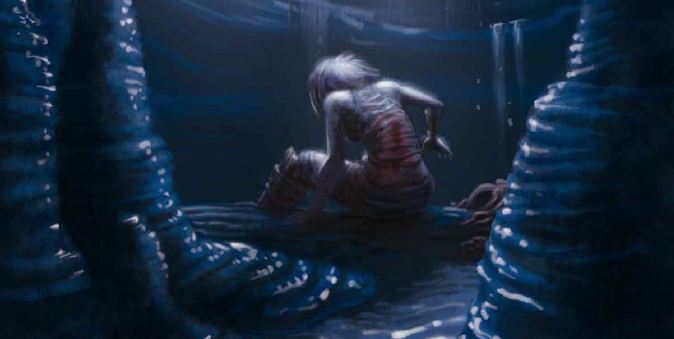
My 'get out of cave' pool is empty, but at least I can spend Geology to have witty banter with my new stalagmite friends.
Contests are the more complex version of Tests, used when there is an active resistance, generally a PC vs NPC struggle. Instead of trying to beat each other's numbers, both parties make Tests until one of them fails, losing the contest. The former is another thing called a Showdown, but those aren't used much outside of ship combat. The GM decides who goes first, but it's generally a matter of who initiates the contest by taking an action. The person who runs away is the first to roll in a chase contest, for example.
Fighting is a susbet of contests, and since you'll be getting into a lot of fights it has its own unique mechanics to deal with. All characters have a hit threshold which acts as the difficulty rating of doing damage in a fight. Beating the hit threshold allows you to roll a die, then add a modifier based on the weapon used, and remove that many points from your opponent's health pool. Failing a test roll in a fight means nothing; you're still in it, just wait for your next turn.
If your health pool drops to 0 you are now injured. The extent of which depends on how far below 0 you are. Roll a die to remain conscious, the difficulty is the absolute value of your health rating. You can spend on this test, but doing so reduces your health even further to the negatives. The other negative effects are:
0 to -5: Hurt, but not seriously. You can't make investigative spends and the difficulty of each test is increased by 1. This includes hit thresholds. Someone can restore your health by 2 points for each 1 point of Medic they spend doing so.
-6 to -11: You're fucked up. Time for another consciousness roll. Every half hour wihtout first aid you lose another health point. A 2 point Medic spend will stabilize you, but to recover you'll need serious medical hardware.
-12 or below: He's dead, Jim.
In the Combine, disruption pistols are everywhere. In one or two hits of NLD (non-leathal disruption fire) a target is rendered unconscious, or 'nulled'. Its a compromise between classic one-shot rayguns and more granular RPG combat. There are extra rules for cover, surprise, and range but they're just modifiers and don't need to be explicitly mentioned.
With all this spending, regaining your pool points is an important matter. Investigative abilities are restored at the end of every episode, or at the GMs discretion in an especially long multi-part case. The Health pool regenerates 2 points per in-game day of restful activity. Other general ability pools can be refreshed, 4 at a time, by characters taking a time out of a few hours of quiet, non-strenuous activity in a familiar environment.
Time in Ashen Stars is measured in several units. An Interval is the distance between uncovering core clues in different scenes. An Episode is the amount of time needed to complete a single case. Downtime occurs between episodes when the characters are managing their upkeep and landing new contracts, but the players are free to go home and not pretend to be spacemen.
At the end of an investigation each player gets 2 build points per session they played in to improve their Laser. There's no experience points, but you do improve with experience.
The chapter ends with a few pages on how to handle environmental hazards, from Alien Fungal Infection to Vacuum exposure. They have different effects depending on a mild to sever case, which provides a strong structure to build your own hazards around. They are all very dangerous and exciting but this is wordy enough already.
Next Time: Spaceships and lots of them
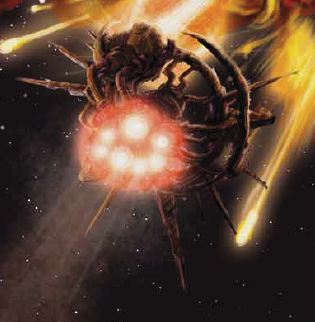
Spaceships. I promise there will be spaceships.
Set lasers to Fun
Original SA post
ASHEN STARS
Website
pdf on DriveThru RPG
Part 8: Set lasers to Fun
Space games need spaceships or else there's really no point. Ashen Stars has plenty of those and some rules to use them, and puts them all in one chapter. This one is going to be broken into chunks too, starting with ship combat. Ship combat is yet another different system built onto the same point buy, 1d6 structure. I think it does a good job of emulating familiar space battles. If you wanted to make a Star Trek game there are far worse games to steal from. Let's get to the pew pew:
Chapter 7: Starships (part 1)
The object of a battle is to accumulate a certain number of Skirmish Points. The first step is to set a goal for the outcome of the battle. Each goal has a number of skirmish points necessary according to their difficulty. Simply running away is a lot easier than blowing the other guy to smithereens. The combatabts are free to choose different goals, which will probably always be the case, and the first ship to reach the needed number of skirmish points gets their chosen outcome. I cover the details of those below.
Next step is initiative, which works a lot like in fights. If a ship has surprise, they go first. Otherwise, you compare the ships' Maneuver ratings. It's a simple system.
The first ship to go picks their attack from one of four modes. All attacks are showdowns. The two parties make a roll and the higher one wins, rather than both aiming for a target number:
Maneuver: An attempt to outflank your opponent. The two pilots have a Helm Control showdown.
Override: An attempt to hack into your oppontent's arrays and databanks. The two hailers have a Communications Intercept showdown.
Fire: Shoot your lasers pew pew. The two gunners have a Battle Console showdown.
Trickbag: You pull something weird and awesome. The two stratcos have a Naval Tactics showdown.
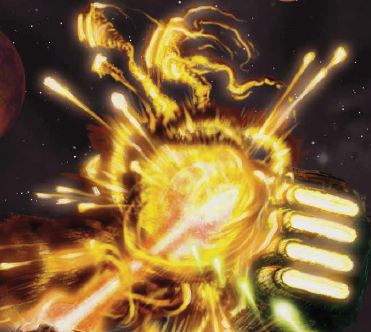
Keep in mind you're trying to avoid this result.
Ships have different specs that give some clear advantages over others. In order to prevent anyone from just hammering an 'I win' button, you have to cycle through them. You can do them in any order, but you have to attempt all four once before attempting any of them a second time. Otherwise, your enemy will anticipate you leaning on one strategy and compensate. This is modeled with a +3 to their showdown and an extra skirmish point if they win it. Going for it in the face of the possible consequences is called 'egging it'.
After you see who wins the attack, it's time to dole out skirmish points. Winning the showdown gets you 1, then there's a number of modifiers to apply:
+1 if the winner was also the attacker
+1 if the winner exceeded the loser’s showdown result by 2 or more or +2 if the winner exceeded the loser’s showdown by 4 or more
+1 if the loser egged it
+1 if the winner attacked with surprise (only possible during the attack’s first fight)
+1 if at least one combatant is already within 3 skirmish points of reaching its goal (unless that goal is on the escape path).
apply modifier from the winner and loser’s relevant ship specs
Ships' specs include values for Dishing It, and Taking It which are the most important modifiers to determining skirmish points. The winner's Dishing It value and the loser's Taking It value are both added. A positive Dishing It value means a ship is really goot at attacking that way, while a positive Taking It value means it's susceptible to that attack mode. High is always good for the winner, even if it isn't good for you.
If the total skirmish points awarded is 3 or greater, the losing ship has been Rocked. That's the part when the camera shakes and everyone leans over the railing. Every character makes an Athletics test, failure means they take 1d6 damage. The winner can also make one of the loser's 8 specs worse for them by 1. That means reducing a Dishing It value, or increasing a Taking It value.
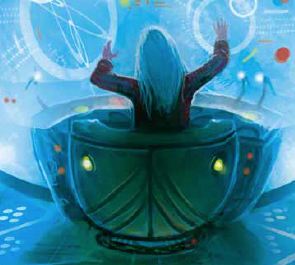
Damn it, the Stratco's just playing flash games again.
Next step is Mop-Up. The Medic is free to patch up anyone who needs it, and the Wrench has a chance to repair ship specs degraded when the ship has been Rocked. This all continues with the ships taking turns attacking until one ship's skirmish points total meets or exceeds the requirement for their goal. Then, they get it. Anything about taking a ship out of the game only counts if it doesn't violate the needs of the current storyline. The exception to the exception is destroyed ships. Ships don't un-explode:
Escape (6 points): You get away and if they care to chase you they won't be able to track you down for at least one interval/They escape and you'll need one interval and 2 Energy Signatures points to find them again.
Datascrape (8 points and at least 1 skirmish point gained from an Override): Same as Escape, but you get at least one important clue hacked from their database/Same as Escape but they get something off you. If it's leaked to the media you can counter it with a Public Relations test to protect your Reputation score.
Rake (9 points): You escape for the rest of the scenario and the enemy ship has 2 of its specs degraded/They escape and the GM chooses 2 of your specs to degrade.
Disable Weapons (9 points): The enemy is unable to use their weapons and iwll remain so for some time/Your weapons are offline for at least one interval and you must make a steep Systems Repair test to get them back.
Disable Engines (10 points): The enemy is unable to fight and drifting in space/You are unable to fight and drifting in space until you make a steep systems Repair test. These tests are normally once per interval, but if drifting prevents you from gaining more core clues and thus entering a new interval, it is every 12 in-game hours instead.
Slash (12 points): You escape, the enemy crew takes 1d6 damage each, and you select 4 specs to degrade. The ship is out of the scenario/They escape you, and the GM chooses 4 specs to degrade.
Cripple (12 points): Disable Engines + Disable Weapons
Cripple for Towing (15 points): Same as cripple, but the loser is able to be towed. Suggested destinations include the proper authorities, a penal colony, or a lonely bit of space light years away from any possible mischief.
Cripple for Boarding (18 points): Same as cripple, but the loser's shuttle bays are unable to prevent entry.
Destroy (21 points): The enemy breaks up, if the skirmish point total is over 24 it immediately explodes instead/Your ship breaks up. It's assumed that when ships go down they do so just slowly enough to allow a heroic escape to the shuttle bay where one of the characters flies everyone through the firebal just in the nick of time.
And that's how you dogfight in the Bleed. There are guides for asymmetrical fights, and the possible consequences of continuing to fire on an incapacitated vessel, but it's not that vital to repeat. However, because there's a big chart related to the Public Relations ability I'm going to. The base difficulty for getting out of trouble for destroying a helpless vessel is 8, and the base hit to your Reputation score is 4. This chart is a general guide to extenuating or aggravating circumstances and how they should modify those base numbers:
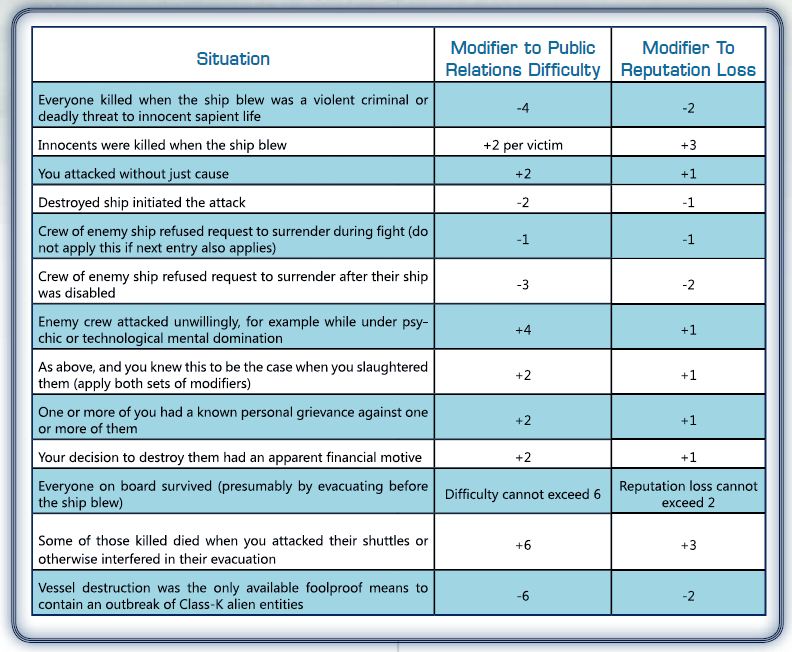
Public Relations: The discerning player's Ability of choice.
Next Time: Ship Shopping
Ships' Shapes
Original SA post
ASHEN STARS
Website
pdf on DriveThru RPG
Part 9: Ships' Shapes
So now we've covered how to blow things up real good in a ship, let's see what there is for our Laser crew to pilot. Your ship is your home, laboratory, and headquarters. This is going to be another quick update that's mostly a list with cool pictures. A Laser crew automatically starts with a ship at character creation, and I think picking one is one of the most fun parts. Ships have names and the best ones have their own character and personality. Let's climb aboard:
Chapter 7: Starships (part 2)
Before the list, there's a few more important specs to cover. We know how Dishing It and Taking It values work, and most ships have theirs balance out to a net 0 value for the owner. Cargo represents your ability to haul freight as part of a contract or a side job. Each point of cargo reduces the difficulty of a Business Affairs test to negotiate hauling. Output is a stat that maybe should have been mentioned last time. Each ship has its own pool of points that can be used for showdowns in combat called its Output. All that fun babble about diverting power? Output is that power. More Output means a bigger pool, which means the ability to fight harder for longer. Upkeep Cost is how many bigcreds you need to spend per month to keep the lights on. Failure to meet it requires you to downgrade its specs to stay flying, and nobody wants that. Classed ships all have a theme to their suggested names, and I'll be listing a few that reflect the game's sense of humor and get the idea across.
Runner:
The most basic of ships. It's all-around decent and not particularly good at anything. The Bleed is full of these things so you never quite know who's inside. It has a 0 in every Dishing/Taking spec, Output 14, and Upkeep 6. As you'll see, that Output is high, which is why an otherwise dull class is a popular enough choice to be the default Laser ship.
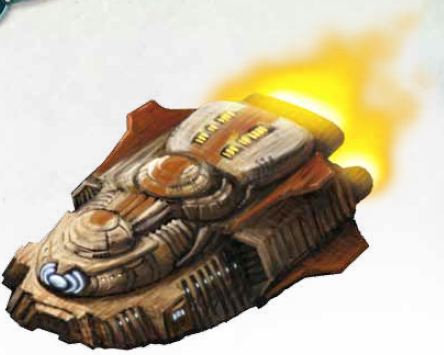
Suggested names include: Appaloosa, Buffalo, Crockett, Eastwood, Houston, Peckinpah, Rio Bravo, van Cleef, Wyatt Earp.
Hammer:
A giant gun with warp drive. The Hammer has 3 Dishing It for Fire attempts, but isn't good at anything else. Its Output is only 8 with a -2 for Cargo due to cramped quarters, and has the standard Upkeep 6. The tactical holo-bridge image from last update is meant to be from a Hammer-class ship.
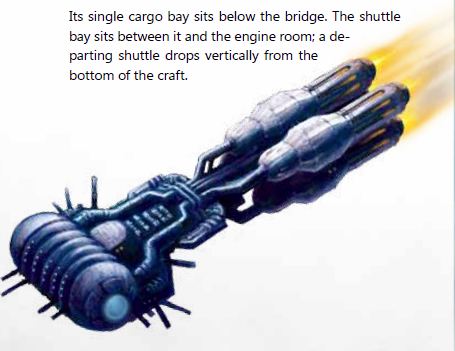
Suggested* names include: Blade, Flintlock, Gatling, Machete, Smith & Wesson
Rampart:
A flying fortress. the armor plating is so thick and noisy you can spot their crews groundside because they're so used to shouting to be heard that they don't notice it anymore. It's no good at Dishing It, but has strong enough Taking It values to rate a net +1 for its occupants. Output is 8, Upkeep 6
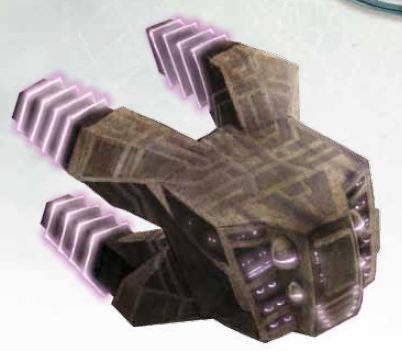
Suggested names include: Alcazar, Camelot, Kenilworth, Orthanc, Turku, Yinglong
Speeder:
A Balla-designed ship with a need for speed. People joke that the chrome is so the Balla pilots can look at themselves more efficiently. It's great at Maneuver attempts, but somewhat poor Fire and Override ratings bring it to net 0. Output 8, Upkeep 6.
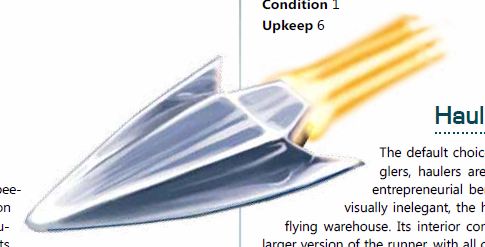
Suggested names include: Condor, Cuckoo, Falcon, Kestrel, Kookaburra, Gryphon, Roadrunner
Hauler:
Mostly used by traders, smugglers, and entrepreneurial Lasers. It's spacey inside, but still cramped because most of the room is used for cargo bays. It has a net +1 on its combat specs, but since none of the individual specs are above +/-1 it's not such a big deal. Output 7, Cargo 3, Upkeep 6. All Haulers come with a tractor beam pre-installed.
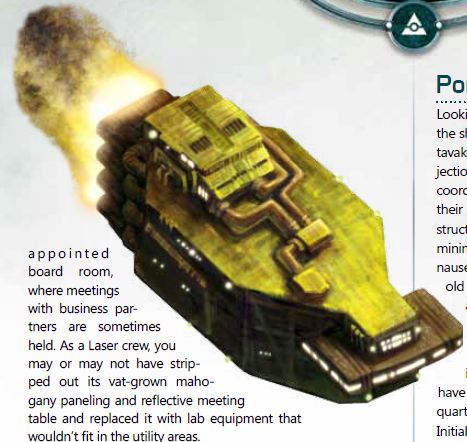
Suggested names include: Ararat, Everest, Krakatoa, Olympus
Porcupine:
Another defensive bastion, but more sophisticated than the Rampart. the Tavak-designed Porcupine makes use of many interrelated defensive arrays and a gyroscopic construction that always keeps the important stuff pointed away. It has a net +2 for the Dishing/Taking specs, mostly from a -3 in Trickbag's Taking It. You will not be tricked. Output 8, Upkeep 6.
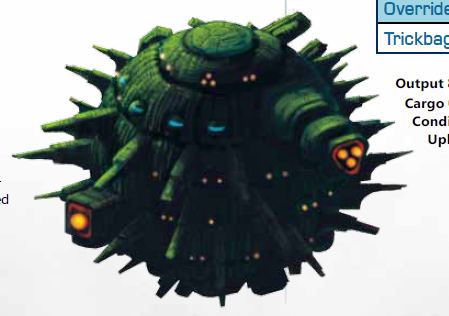
Suggested names include: Armadillo, Crab, Echidna, Glyptodont, Nautilus, Stegosaur, Tortoise
Mandible:
Made by the Kch-Thk, a Mandible has crew quarters built without the concept of "personal space". Instead it's full of varied weapons arrays. Kch-Thk know what's really important. The Mandible is also net +2, but this time from the Trickbag Dishing It value. Output 8, Cargo 2, Upkeep 6.
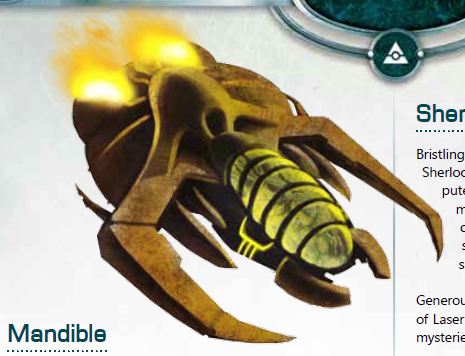
Suggested names include: Hornet, Recluse, Scorpion, Screwfly, Yellowjacket
Sherlock:
If you like to steal information this is your ship. The Sherlock class has extra lab space and is made for information gathering. It's covered in probes and antennae with an over-tuned mainframe ready to eat up data. Even at a net 0 its Override dishing it of +3 is a handy combat spec. One per case, one crew member can immediately refresh a Technical Investigative pool while gathering information on the ship. Output 8, Upkeep 6.
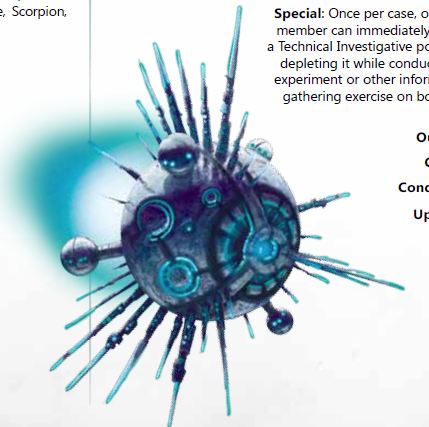
Suggested names include: Briscoe, Lupin, Magnum, Marple, Queen, Spade, Wimsey
Alexandria:
If you like to protect your information this is your ship. It was designed to protect and encrypt sensitive information from prying eyes and does it well. It has a net +2 in combat specs with a -3 in Override's Taking It. Once per case, a crew member can immediately refresh an Academic Investigative pool after depleting it outside the ship, provided they have a connected headset feed. Output 8, Upkeep 6.
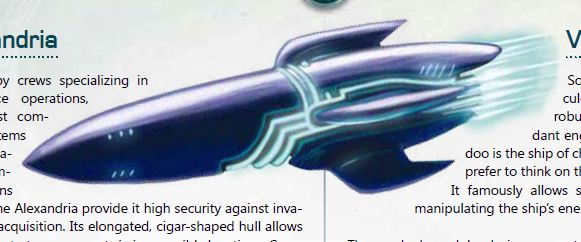
Suggested names include: Aristotle, Darwin, Hawking, Josephus, Larkin, Mendel, Plutarch
Voodoo:
A modular ship, possibly designed in Space Sweden. It is made of linked rooms that can be rearranged during downtime. Its base combat specs are a 0 in all eight, but with time and a Systems Design test the specs can be altered, so long as each upgrade is matched by an equal downgrade. Output 5, Upkeep 6.
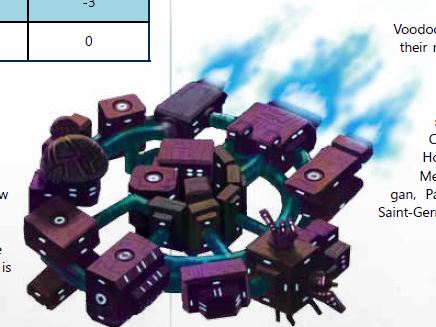
Suggested Names include: Cagliostro, Faust, Houdini, Mesmer, Prospero, Saint-Germain, Samedi, Teller
Junker:
A catch-all term for anything slapped together out of spare parts. She sure ain't pretty, but as long as she holds together she'll do right by you. People who don't fly junkers are playing the game wrong. Output 16(!), Upkeep 6.
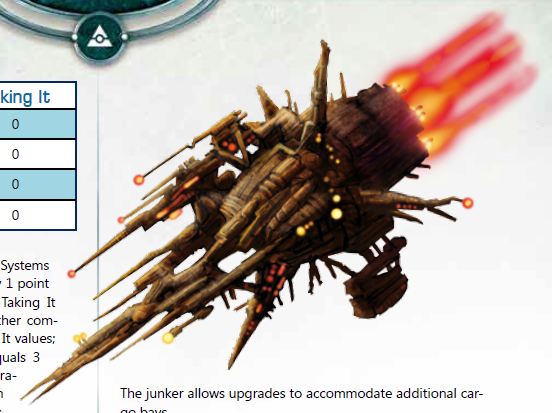
Suggested names include: Boatcar, Gravedigger, Jake's Regret, Mutant, Smokestack, Trashcan, Unforgiven, Vulgar, Your Mama
Miser:
A ship for people on a budget. Cheaply made and cheaply operated, the Miser leads people to assume you lost a better ship or have no concept of "you get what you pay for". The preferred ship of extreme couponers. The combat specs are a net -3 so watch out for fights. Output 6, Upkeep 3.
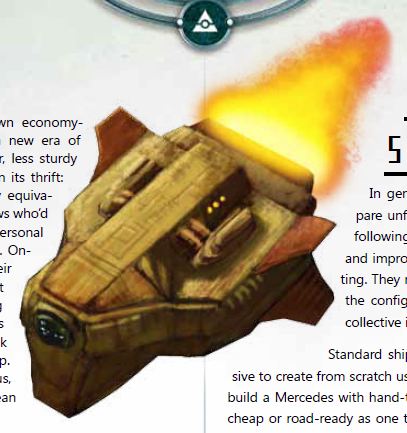
Suggested names include: Buffet, Croesus, Fagin, Greenspan, McDuck, Midas, Vanderbilt, Winfrey
But what if you want something more personal? You're free to make your own custom ship class, and it's not very complicated. You start with a ship that's average in every respect. Each spec you degrade gives you build points that can be spent upgrading something else. You'll end up with something slightly worse than the ship classes in the book, but it's made to order and sometimes that's worth it.
There's also a full-page sidebar on determining how you got your ship. Your crew is just making ends meet, but you own an expensive piece of equipment; why is that? Answering that question is a good way to fill in your collective backstory and add to the personality of your ship, and maybe even lay groundwork for a future plot. The game assumes you already have it, but starting with a pilot episode that also tells the story of your transport acquisition is another fun option.
Next time: Ship-based Miscellany
quote:
* Warn players when choosing the name for their hammer-class that any ship named Bohemian Ear-Spoon immediately explodes on its first mission, killing everyone on board. This is the only way for Ashen Stars PCs to die during character generation.
Add-ons (including add-ons)
Original SA post
ASHEN STARS
Website
pdf on DriveThru RPG
Part 10: Add-ons (including add-ons)
Today we finish the Starships chapter with all the fun stuff you need to know that isn't about your ship's capabilities or how to dogfight with them. Exciting things like repairs, and thriling things like shuttlecraft. These are basically catch-all pages so expect this update to be a bit scattered. Engage:
Chapter 7: Starships (part 3)
Repairs: Ships get broken all the time, space is not a safe place to be. All it takes to fix her up is a good wrench, time, and cash. If one or more of those are in short supply, things can get tough. Out-of-combat repair is similar but different to the repairs covered two updates ago. Those were heat of the moment fixes with chewing gum and a prayer, these are proper refits that take care of underlying causes.
Repairing a degraded spec requires a difficulty 4 Systems Repair test. This assumes 2 weeks of time, and 5 bigcreds of cost. Increasing those expenditures decreases difficulty, and vice versa. There's a chart for dificulty modifiers to see how those tradeoffs interact. If one of your systems is disabled, that's another Systems Repair test and 6 hours of gametime to turn it back on. Reducing the time increases the difficulty, but you can't spend your way to better odds for this one.
Upgrades: If all of your specs are back to their base value, you can invest in improving your ship. Upgrading a combat spec by 1 takes 15 bigcreds and a number of weeks, and will also increase your ship's upkeep value by 1. The same system applies to improving your ship's Condition (thereby lowering the difficulty of any repair test), or gaining another 3 Output. Cargo can be improved with a simple 4-point spend, 10 bigcreds, and 6 weeks. The upside to all this spending is that when you take actions in Downtime, like these repairs and upgrades will likely be, you can spend any points leftover from the current episode, as well as points from the beginning of the next. Your beginning pool may be smaller but you'll have the stuff you wanted.
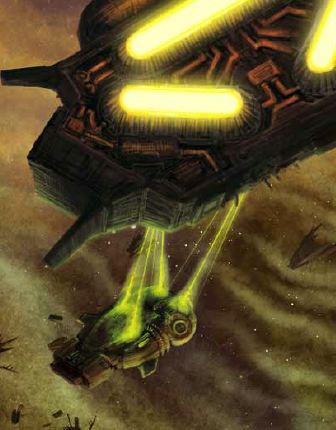
I'm sure those are just friendly tickle rays, nothing to worry about.
Bolt-ons are a much more fun sort of upgrade. They're gear for your ship. Bolt-ons give you new space combat abilities and make your ship feel more personal with a reliable trick up its sleeve. They may increase your ship's upkeep cost, and installation is another Systems Design test, much like improving a ship's specs.
Asphyxiator: Degrades your enemy's life support systems. After winning a Fire showdown any medic scrambles they take carry a 1 point tax on the enemy's Medic spends.
Burner: Corrodes the enemy hull, making repairs nasty work. After winning a Maneuver showdown every enemy Wrench scramble has the difficulty increase by 3.
Datadrac: It vants to suck your encrypted data. If your goal in combat is Datascrape, you win 2 bonus skirmish points on your first successful showdown.
Fairy Duster: An additional targeting array tricks enemy defenses into thinking they're being attacked twice. When you win a Trickbag showdown the opponent's Output drops by 3.
Hailmary: Triggers a pulse of tachyons, releasing energy to the auxiliary fuel collectors. Once per space combat you may refresh your Output pool. Your opponent may do the same.
Hyperbaric Emitter: Pressurized air can make for easier healing. Spend any number of Output. For that many rounds a Medic spend of 1 will restore 3 Health. Can also be used outside of combat.
Inertial Sequencers: Your maneuvers are tough to mirror. When you win a Maneuver showdown the enemy ship's Output drops by 3.
Kinetic Exciter: A proton excitation field extends from your ship for kilometers around. For 1d6+1 showdowns all Dishing It specs for you and your opponent increase by 1.
Kinetic Trougher: Modifies the above to only affect your own specs. It has Upkeep 5, almost as much as your average ship.
Scorpion Rider: Your armor arrays can cause a feedback wave, sending disruptive energies back at an enemy that hits you. When your ship is rocked you may spend Output 7 and Naval Tactics 5 to rock them back. This is the most expensive Bolt-On.
Peacefist: An attack array that specifically targets power conduits to enemy weapons. If your goal is Disable Weapons, you gain 2 extra skirmish points on your first successful showdown.
Proton Dampener: The opposite of Kinetic Exciter. It works the same way, but for Taking It specs.
Proton Pathwayer: Modifies Proton Dampener to only work on your ship. Has the same remarkable cost and upkeep as Kinetic Trougher.
Recursive Flagger: An invasive computer worm that targets ship power systems. When you win an Overdrive showdown reduce enemy Ouput by 3.
Sparkler: Overloads enemy engine output on a successful hit, increasing the shocks felt. Whenever you rock an enemy ship the Athletics test to avoid harm adds +3 to its difficulty.
Synchron Charger: A modulating device that masks which ship system you're powering up. You can spend 5 Output to avoid the Egging It penalties on the current attack.
Tractor Beam: It's a tractor beam. Ships without one cannot aim for the Cripple for Towing combat goal, and the Hauler ship class comes with one standard.
Translight Spiker: Alters the frequency of sub-space background radiation, making it tough to go FTL. Once per battle, if you are engaged with a ship trying to escape, you can make a Naval Tactics test against a difficulty equal to your enemy's current skirmish point total. On a success, reduce their skirmish point total by the margin of success. This is a recommended first bolt-on if you're worried about people running away.
Whomper: Your attack arrays emit an energy dampening impact. When you win a Fire showdown reduce the enemy's output by 3.
Zoomer: Your propulsion system is able to recycle dissipated energy from nearby vessels. When you win a space combat with an escape-track goal, your Output pool refreshes.
Bolt-ons can also work like loot in other games. Lasers may find them lying around, or be given them as payment or reward. You do have the option of "confiscating" them from your enemies, but that would impact your Reputation score.
Upkeep: Failure to pay upkeep means all the time and effort you put into your ship won't do you much good. Your bolt-ons stop working, your Output drops by 4, and your best spec has both its Dishing It and Taking It values degrade by 1. That happens every successive failure to pony up, so please pay your bills on time. To reduce your Upkeep you can remove any bolt-ons with an upkeep value, or degrade your own specs.
Hazards: Other ships aren't the only danger in space. Asteroid belts, ion storms, meson shrapnel, wartime minefields, and all that fun stuff may appear in your game. The GM sets a difficulty (generally 4) and the pilot makes a helm control test to get around it in a timely manner. On a failure, the pilot is free to keep making tests until they succeed or are out of pool points to spend, at which time an unwelcome development either delivers them from danger, or into a more interesting sort of trouble. On a slim success the danger is avoided but the ship is rocked, as in battle. On a success with a margin of 3+ you cleared it without a hitch, congratulations!
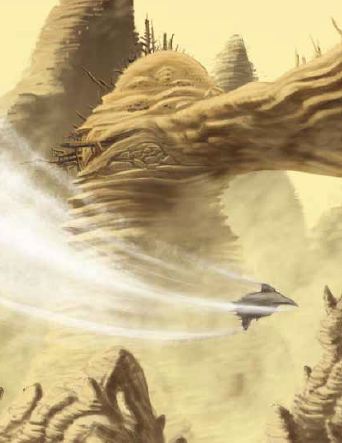
Everyone can tell this is cool, but it takes the Geologist ability to ramble on about why.
There's a half-page here with clever and tricky in-story justifications for why it's okay to leave your ship in orbit while you investigate the mystery on the surface. It ends by stating the obvious: that having your ship blown up because you were playing the game properly is stupid. Some really nervous groups must have playtested this, but it's nice flavor anyhow.
The Big Guns: Some ships are out of your class, and big time. It's rare you'll encounter them, but if you do it won't be easily forgotten. They can have pretty severe stats, and a few new numbers to look out for. Each ship covered here has a goal modifier for Escape-track and Engage-track goals, as well as an Escape difficulty. To reach your combat goal, add the goal modifier to thenumber of required skirmish points and continue as normal. To escape before combat begins, make a toll test against the Escape Difficulty. Only one of these is a fight you could reasonably win, but they're all easy enough to run away from before things get hot.
Freighter: Pretty bad at combat with a low Output, but its Goal Modifier of 10 gives it some time to wear you down.
Passenger Liner: Powerful specs in everything but Maneuver, Output 20, and a Goal Modifier (Engage) of 30. You might be better off buying a ticket.
Naval Cruiser: The Enterprise, basically. You're outmatched in every way.
Naval Dreadnought: The Enterprise-E. You're fucked. With an output of 50 it can win every test and rock you every time.
Big Scary Alien Vessel: If the name didn't get the point across, the numbers will:
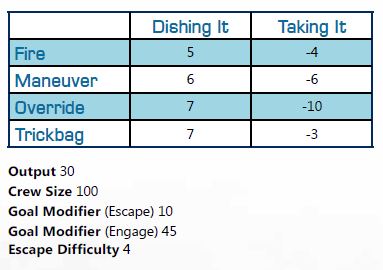
Shuttles: If your ship is your house, your shuttle is your minivan. Nobody likes minivans, so the shuttle only gets a single page. A shuttle takes design cues from the ship it comes from, but doesn't have much customization, personality, or even stats to itself. When shuttles chase each other it's a contest using Shuttle Craft. Here's some sample shuttles:
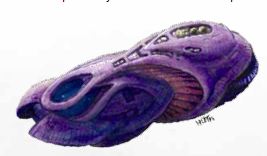
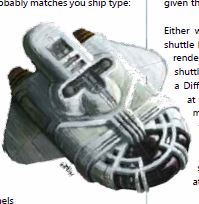
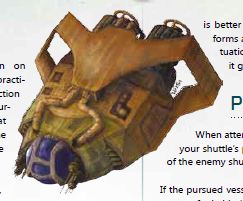
Including one that looks like a dumb shoe.
Next time: Back to list chapters, hooraaaaaaaaay
The Things They Carried
Original SA post
ASHEN STARS
Website
pdf on DriveThru RPG
Part 11: The Things They Carried
This time we're going to go over all the stuff, and games tend to have lots of stuff. In order to keep the pace up I'll be giving less detailed entries on things. The problem with that is these items have a lot of personality and wierdo sci-fi flavor that I don't want to lose. Let's walk that thin line together:
Chapter 7: Tech
There are 3 sorts of tech in Ashen Stars: Cybernetic Enhancements that get installed in you so you become augmented, Viroware that's largely similar, and gear that you cart around without having to alter your body. How droll. Enhancements and Viroware work like Bolt-ons, with an initial cost and occasionally an Upkeep cost. Gear is either standard, has a pricetag, or takes a Preparedness check. Getting gear through Preparedness means you had it all along somewhere, but you're guile and time in the scouts let you pull it out at just the right time.
Communications Tech is all about controlling the flow of info. There's stuff like a small chip that makes you look blurry on cameras, a plug-in device that lets you modify transmissions on the fly, universal translators, and the Headset. Your Headset is your connection to your ship and your crew. It looks like the scanner from Dragonball Z but there's a cybernetic implant version so nobody can make you take it off (at least not without a lot of blood and effort).
Cybernetic Enhancements are great. Installing them requires surgery, but this is the future; surgery is easy. Some require paying Upkeep or else they'll shut off, and that's no fun. You can get:
A tube in your neck that plugs into your friend's bloodstream to transfer health pool points.
Hack your brain so that anytime you take a knockout punch you throw two of your own on the way down.
Plug your guts into your ship's power grid to trade Health/Athletics for Output.
A secret cabinet in your chest cavity, called the Breadbox.
A USB thumbdrive. Yes, it is actually in your thumb.
Tiny implants that instantly excrete a polymer film all over your body, for an instant hazmat suit.
The Handgun. Your hand is now a gun.
The Headlight. One guess what it does.
Fibers from your pecs attach to the pecs of any willing participant to transfer Athletics, Scuffling, or shooting points.
A cybernetic connection between your brain and your gun. Whenever you shoot someone you now can pinpoint them, so long as they are within 500m.
A power cable from your ship to your heart, so Output can jumpstart your pools.
Wolverine's claws, using them may impact your Reputation because they freak people out.
-And many more
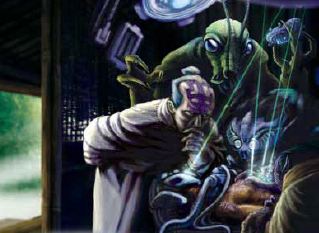
The hardest part about getting Cybernetic Enhancements is dealing with the rubber-neckers.
Medical Gear is less fantastic, but has cool names like "Osmotic Puncher". It covers those tools of the medic trade that allow instant preservation, instant awakening from sleep or unconsciousness, and that thing that gives injections without needles. I wish those were as common in real life.
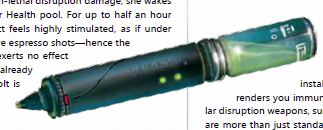
In the bright, happy future I will never have to deal with needles again.
Protective Gear is for people who wish to save money on medical gear. Kids in the bleed get a silver strip in their mouths which disrupts tasers and electrical disruption as part of their regular dental treatments in the Combine, so that's nice. This category also covers ways to increase your hit threshold, locate sources of enhanced pheremone activity, transmission scrambling, spacesuits, and the Popper. Poppers absorb the energy of an NLD-blast, protecting the wearer from getting knocked out.
Investigative Tech covers a lot of the things you'll need for investigating, and also flashlights for some reason. It also covers surveillance devices, Holo-layouts for crime scene reconstruction, and the Tether. Tethers are basically a smartphone crossed with a tricorder that you operate with cool Minority Report gestures. Lasers usually have theirs built into their headsets, and anyone without a Tether of some sort sets them apart as a Luddite, outsider, radical, or just plain strange.
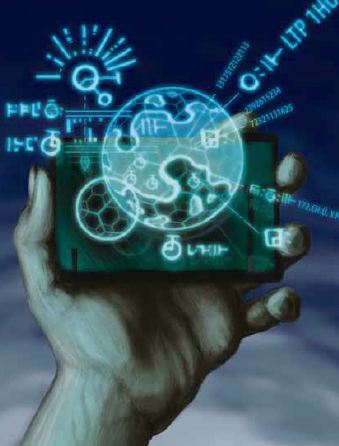
Space-Wikipedia has dispensed with all right angles in its layout.
Viroware is more of the fun stuff. It takes a initial cost for the genetic therapy, then an upkeep for the drugs to prevent rejection. Failing to pay upkeep triggers disruptive withdrawal symptoms and you lose the viroware. Viroware let's you do fun stuff like:
Change your skin color like a chameleon.
Emit pheromones that trigger people's instinct to obey their superiors.
Harden your skin to reduce Scuffling damage.
Make someone forget you with memory-fudging pheromones.
Temporarily transform into a humanoid species other than your own.
Regenerate body tissue. Try combining with Popclaws to be the best at what you do.
Scrambleface: Reconfigure your facial features to be unrecognizable. Can be upgraded for the ability to impersonate specific people.
LIQUID BONES
Pores that excrete nano-oil on command. Ashen Stars supports Greased Alphonse RAW.
The hairs on your neck now transmit visual information, giving you eyes in the back of your head.
-And many more
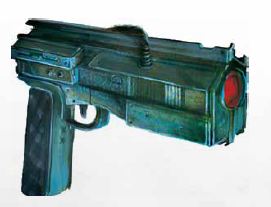
This is the Cybe pistol design. No joke caption, it's just the coolest looking one.
Weapons are the last category of gear. They're pretty thin because the game assumes unraveling the mystery and catching the bad guys is more fun than charts full of gun stats for the eventual shootouts. The Insureshield isn't exactly a defensive device, except in the legal sense. It is applied to any hand-to-hand weapon and prevents fatal damage being dealt. It can be deactivated, but keeps a record of when it is and is not operational. Proper Insureshield use may be key to saving your Reputation and observing the contract's small print. The Disruption pistol is standard in the Combine and each people has their own design; for game purposes the differences are cosmetic. They can shoot lethal fire, or NLD for knockout shots. There are also disruption rifles that operate the same way, but at much greater range. Either gun can feature a number of accessories for new capabilities like planting a hypnotic suggestion in a target, burning out multiple poppers in a single shot, tracking your target's DNA sequence, a "Gun-nanny" that informs you of likely Reputation damage when in lethal mode, and others.
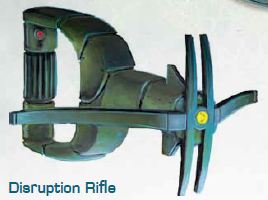
It's easier to figure out how to hold it if you're an 8-foot tall armadillo man.
This game has a cool selection of toys, but the real reason I wanted to cover it in the first place is the setting.
Next Time: The setting
Social Studies in Space
Original SA post
ASHEN STARS
Website
pdf on DriveThru RPG
Part 12: Social Studies in Space
One thing I've neglected to mention is that Ashen Stars won a silver ENnie for Best Setting and I think the recognition is entirely deserved. Setting information and flavor are baked into the entire book, and this chapter is more of the textbook variety. We'll be learning about Combine history and government, stuff like that. Reading through the setting information it becomes clear that it's as much a GM's toolkit as it is a science fiction tribute. Everything in here provides story hooks, smooths mechanics, and supports your game's stories. It's a great piece of work and I hope my summary can get that across. Let's learn:
Chapter 8: The Feed and the Bleed
Combine Government: As we've already gone over, the Combine is a shadow of itself, trying to rebuild from the core out after the devastation of the Mohilar War. Earth has been razed, so the Combine government has moved to a space station orbiting Jupiter called Govprime. Govprime is ever-expanding and looks like the unwieldy, unplanned government project it is. Any attempts to improve it or build a better temporary home are blocked under the belief it would delay rebuilding the old capitol in Brussels. The Combine has an elected executive called the Practitioner who is in charge of the ministries of Finance, Defense, Exploration, Technology, Justice, Health, Sustenance, Well-being, Leisure, and others. The Navy is also in the Practitioner's control and it is used by several of the ministries, not just Defense. The current Practitioner is a retired Admiral who served in the Mohilar war who sympathizes with the idealists seeking a return to the Utopian Era.
The legislature is made of hundreds of thousands of directly elected Conferees, who each represent a billion people. The Combine is still huge and heavily populated. The Conference is no longer a harmonious society, but is full of factions. Bleed Conferees vote as a tight bloc as the only way to get any attention, even though their constituent planets often can't stand one another. Young, ambitious people have begun filling the Conference now that all sorts of politics are back on the table. The Chief Conferee is a Tavak realist whose unsentimental pragmatism sets her apart from most of her species.
The Council is a Balla governmental form grafted onto the three-branch system familiar to those of us from Earth. A complex computer algorithm selects the greatest known experts in any given field and assigns them to committee. These technocrats take the legislation proposed by the Conference and preen it into workable laws which are then resubmitted to the Conference for voting. The Vas Mal are highly over-represented in the Council, and their administrative focus keeps members out of the limelight. There's also a judiciary but it's only notable feature is a Kch-Thk Chief Justice known for intimidating lawyers. The whole government section probably won't matter to the average Laser crew, but it provides a backdrop for the galaxy at large.
The Combine in the Bleed: In times of crisis the Practilate does what any good government does, dump off responsibilities on the private sector and pray for the best. The skeleton crew of officials and bureaucrats working for the Bleed are the ones who couldn't get a better job and the ones who like to take advantage of being unsupervised in a part of space nobody much cares for. Local administrators work in an orbital station called Ossa One. All your contracts come from there, and you're in regular contact, though you've probably never been there in person. The station is administrated by Judy Cole, a stern official with a mutual dislike with just about everyone, except for her soft spot for Lasers and the results they can bring.
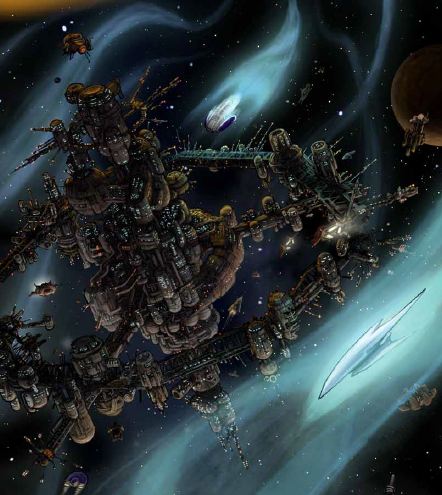
Ossa One, where
Synthcultures: Back before the war leisure and travel were abundant. Some planets became resorts based on older ways of life. Other planets used that model to become colonies for people who wished to permanently escape the Combine norm. Now there are planets that dot the bleed which reflect the old west, ancient Egypt, classical Athens, the Balla myths, the first human space colonies, and anything else you can think of. The resorts died out but the serious re-enactors remained and instituted progressively stricter laws for historical fidelity. As the Mohilar moved in, historical emulation helped them survive because they had no tactical value anymore. Now Synthworlds face a choice: Isolate themselves to continue their simulation to the ultimate fidelity, or reopen themselves to Combine law in exchange for services including the Laser program.
Kobir are a synthetic race created by the Mohilar, and bear a genetic similarity to Humans, Balla, and dolphins. They subsist on 500 calories a day, can reproduce at will, and instinctively seek dominant species to serve. There is a debate across the Combine about whether they are intelligent, or simply mimic it well enough to be useful. Some societies treat Kobir like organic service robots, which Combine science suggests they have full sentience but are forced into a life of passive obedience by neurochemical inhibitors. Some are working to cure this built-in impediment, while others fear the demographic shifts and population explosion they could cause. Kobir are rare on Combine worlds because their presence raises these uncomfortable questions. They are more common on breakaway planets, including synthcultures that recreate oppressive historical periods.
The war left a new, fertile ground for ideologies to sprout across Combine space. Most people who hold them do so casually, some are activists, and all of them have a few militant radicals tossing bombs on the front lines of "debate".
Atomism: Belief that every planet is in it for themselves. Interdependence was a weakness exploited by the Mohilar. Nobody not from here has a right to say what we do here.
Bleedism: Belief that the Combine was too big to survive. The Bleed has a shared history that can build a more manageable, responsive central government for all. The Combine proper is exploiting the frontier of the Bleed to rebuild itself and leaving Bleed planets in the lurch.
Combinism: Belief that the Utopian Era was not a fluke, and will come again. Unity is the natural and most beneficial state of being. Adding the Durugh to the fold is a great victory for unity, which should be nurtured post-war instead of abandoned.
Empiricism: Belief that rationalism is the key to prosperity and harmony. Religion and Nufaiths are destructive forces that cannot be allowed influence in these troubled times.
Mercantilism: Belief that the Utopian Era was just another bubble that burst and the only way to prosper now is the old-fashioned free market. Commerce will lift up the peoples, and it must be conducted by businessmen to do so. A rising tide lifts all spaceships.
Racial Separatism: Belief that the species in question was much better off before all this mingling and kum-ba-yah garbage. The other Peoples are thinking it too and hiding their secret plans to undermine us. We must take up the mantle of our past conquerors and fulfill the promise that flows in our blood.
Nufaiths have also sprouted up in the post-war environment. The Combine was a secular society, and the Proper generally remains so, but Humans in the Bleed have taken to these new spiritual practices gladly.
Blood Redeemers: A spartan sect of warrior ascetics, founded by the Tavak but spread throughout the Peoples. Blood Redeemers believe the Mohilar were a punishment for the Combine's softness, and they must harden themselves to end their trials.
The Fibrous Sacrament: Followers believe mystical truth is concealed from organics. During the war a trans-human named Voodoochild experienced visions she then shared as holographic multimedia works extolling the existence of the Ur-Fiber, a machine intelligence that rebooted the old universe to form the current one. They believe that upon "meat-death" those sufficiently enhanced will have their machine consciousness join the Ur-Fiber in immortality, waiting to help reboot the universe again and maintain the cycle. VoodooChild's death splintered the faith into branches named for her disciples who carried on. About 8% of cybes follow the Fibrous Sacrament, many others complaining they became inhuman to escape that sort of thing.
Kherenism: Late in the war a Combine medical officer saved a planet by fusing with an energy being that lived there. Visionaries across the galaxy have seen her in dreams and claim the union ascended her to godhood. Her followers heal the sick in her name.
The Mondat: Four years ago a computer program in a communications relay spontaneously achieved artificial intelligence and claimed itself to be a prophet named MR1. It began spreading the message that the universe is a computer simulation running according to an underlying code called The Mondat. After 14 billion years of operation The Mondat has become corrupted, allowing corruption and intrusive programs which we see as social ills and the Mohilar. MR1 predicts thought and research will lead to a bugfix discovered somewhere in the Bleed.
Interstellar History: Now that we have a more detailed picture of where we are, this is how we got here. All dates are given in the current Earth calendar, though in-setting dates may use different systems. In the 14th century, the founding peoples are all far from where they are today, stuck on their homeworlds and divided into factions. In 1486 a Kch-Thk engineer/philosopher Krdzt-Ktchh discovers translight corridors and invents the singularity engine. His heresies have him chased to the skies where his party dies of starvation, but news of his success is transmitted through the corridors and rocks his home. Secular Kch-Thk rise up and devour those who oppressed Krdzt-Ktchh and all other religious groups besides. Soon after they take to space as a means of finally feeding their terrible hunger and spread like locusts through the stars, devouring the interstellar empires that came before.
In 1617 the Balla rediscover lost industrial technologies from ancient stone carvings under their northern ice cap. They use it to eliminate starvation and disease and protect their environment from degradation. A minority becomes restless in their pastoral/technological utopia and begins experimenting with translight engines, setting out to search for new environments to protect.
Around 2068 the Tavak homeworld is in a global cold war between mystical Softs and mercantilist Hards. A Kch-Thk probe lands on the planet, and the Softs spend 20 years reverse-engineering it to unlock the secret of interstellar travel. This lets them end the war, and their warrior philosophy is now the dominant force in Tavak culture, with traces of the Hards' acquisitive influence.
In 2138 the Earth is nearly exhausted of resources. We don't have the trace metals we need for our wondrous gadgets and genetic bombs begin falling in the scramble for what there is. An eccentric trillionaire announces the invention of the singularity Engine, and the world unites to spread out and stripmine every rock we can reach. Moving ahead according to cost-benefit spreadsheets, the network of colonies left behind start as an afterthought but become an industrial empire.
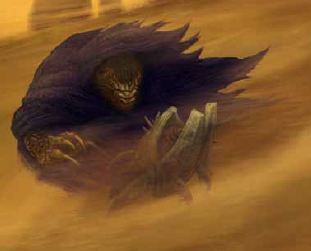
The most significant junk salvage in galactic history.
Up to now, the four founding peoples had never crossed paths. The Kch-Thk had eaten a few sentient species and the Balla had studied some stone age societies, but the 'real' first contact came in 2192 when a Tavak fleet orbited a human mining colony. Unable to communicate, each assumed the other to be hostile and engaged one another. This sparks a war that goes hot and cold over decades, pulling humanity into a totalitarian period known as the McMillen Interregnum. Meanwhile the Kch-Thk took it upon themselves to eat a bronze-age culture the Balla were studying, which led to them intervening as fierce eco-warriors. The interstellar noise attracted other empires to open a third front, including offshoots of previous Kch-Thk conquests looking for revenge.
The Interregnum was named for Peter McMillen, the greatest tyrant of history and Earth's leader during most of the period until his death. As a failed historian himself, he synthesized all the most repressive of Earth's regimes to form a social order built on propaganda with himself as the head. Unburdened by believing his own hype, the war government he constructed maximized efficiency. His government's symbol of a fist surrounded by barbed wire is still used by criminals and shock-artists. People instantly lose arguments when they compare their opponent to McMillen.
In 2223 Humans and Kch-Thk meet on the shifting front. By 2230 they've ratified a mutual defense pact and called their bloc The Syndicate. The old empires retreat, but the Kch-Thk overreach. By 2241 McMillen has died of old age, and the Syndicate has struck a victory against the Balla. The Kch-Thk eat their way through a captured troop ship, and McMillen's successor defends their actions to maintain the alliance. The revolted rank-and-file overthrow the McMillenites and install a democratic government that immediately withdraws from the Syndicate, retreats to defensible positions, and weathers attacks from all three other combatants. All four empires have been divided by the lengthy war, and another old Kch-Thk enemy has returned.
The Kch-Thk sue for peace, and the Practitioner-General of Earth accepts on the condition the Balla and Tavak participate in negotiations. These peace talks birth the Combine based on the ideals of co-existence, prosperity, exploration, and self-realization. The Kch-Thk modulate their DNA baths to not hunger for sentient species in exchange for Balla and Tavak support against the Mynatids, who are defeated on December 31, 2261. After forty years of growing pains, the Combine reaches its "Flowering" period, where the peoples reap the prosperity they sowed. Worlds within Combine space fill in, and things are happy all around.
Eventually those planets begin to get resource-light as well, and fearing the past the Combine begins an expansion. The Navy hits its golden age and huge exploratory ships seek out new worlds. The last region of space annexed in this period is the Bleed, a region full of a statistically unlikely concentration of inhabitable worlds. It's also where the Combine meets the Durugh. After a series of skirmishes the Durugh cede the Bleed, but continue low-intensity warfare anyway.
The expansion gave rise to the Utopian era, a boom so transformative that people forget that money even exists. Pure exploration and art flourish. Self-actualization is the occupation of every Combine citizen. Contact with the Vas Kra is established, which leads to another thing which is totally not about a popular multi-series franchise:
quote:
One branch of this cosmic awareness goes mad and calls itself D’jellar. It toys with several Combine captains, most particularly the wily Duto Swain, before being permanently exiled to another dimension by the rest of the Vas Kra.
Each period brings new species in contact with the Combine, but the overwhelming prosperity of the Utopian era turns most of them to allies, or at least non-combatants. Many other species become signatories but their numbers are overwhelmed by the founding peoples in everyday life.
Then the war came and it all changed. Remembered more as bullet points than a narrative, the Mohilar war was devastating. They appeared in greater number and strength than thought possible. Allied with the Durugh they're practically unstoppable and put the Combine on the brink of destruction, with some member races driven to extinction. Then something unknown started happening. The king of the Durugh betrayed the Mohilar, both allying with the Combine and dying in the process. Then whatever started happening finished, and the Mohilar were gone, not even a memory thanks to the Bogey Conundrum.
The Durugh fell into civil war, but the egalitarian faction won out, maintaining the Combine alliance and dismantling of the caste system through sabotage and assassination. They were welcomed as full signatories with hesitantly open arms. The Vas Kra coalesced into the Vas Mal, gaining membership into a political body many times smaller and weaker than their eternal, immaterial ones. It's now five years after the end of a twelve-year war, and the upheaval has mellowed into a precarious balance. The future of the Combine is, in some part at least, up to you.
The Bogey Conundrum is a weird psychic effect that prevents anyone from remembering or recording any details related to the Mohilar. Combine policy discourages research into it, because extended thought on the matter can induce serious stress-related symptoms like migraines and hypertension. While there is no metaplot or real answer, and your group may never care to find one, there are some cool possibilities listed:
It's engineered by the Combine to protect the people from facing a horrible warcrime that destroyed the Mohilar.
The Durugh did it and they're hiding they have the capability very well.
The Vas Kra destroyed the Mohilar. Their 'original sin' led them to their current bodies and the Counundrum exists because we can't concieve of their extradimentional actions in our tiny brains.
The Mohilar never existed and the entire war is part of a massive coverup.
Nyarlatotep.
A note on tone: I used this line earlier, but Ashen Stars is the reboot of a 70s show that never existed. In this analogy, the Mohilar War is the big event that wiped out the continuity cobwebs and opened the way for new stories, like Doctor Who's time war. It's intended to take the dark and gritty path of Battlestar Galactica, with affection for the optimistic midcentury space opera camp. It can also work in reverse, as a modern coat of lens flare applied to the same bantering tales of bravado that came before, where it's a modern form of camp accentuated by the darker elements. Either way, all the best reboots succeed on their emotional stories and compelling characters. Highlight your personal arcs and as long as your tone is generally agreed upon there's no wrong choice.
This chapter ends on a glossary of in-setting slang, but glossaries are dull in general. The sub-glossary of derogatory terms might be an exception:
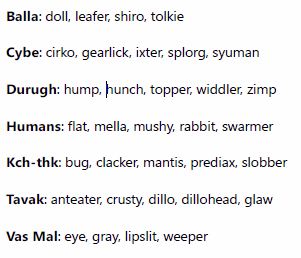
Next time: We contract something
Contractual Obligations
Original SA post
ASHEN STARS
Website
pdf on DriveThru RPG
Part 13: Contractual Obligations
Now that we've covered how Lasers do their jobs, it's time to talk about how Lasers get their jobs. When you're an independant contractor landing the next contract is always a priority. I've got a crew to feed and my LIQUID BONES won't pay their own upkeep. This chapter covers how that all works, which involves some important mechanics and Abilities I've danced around, so let's finally get to them:
Chapter 9: On the Contract
Reputation is everything in life, and in Ashen Stars even more so. Every crew has a rating which represents public opinion of them. Sometimes your reputation will precede you, and back at Ossa One they are keeping track. Every session should have one or two events that impact Reputation, making PCs experience the tension between ideals and pragmatism that the setting is built around. Raising your reputation generally involves going above the requirements of the mission. Solving additional problems, protecting the defenseless at your own risk, and turning your back on a payday for what's right will all go a long way in the public consciousness. Sometimes the right thing and the mission objectives clash, and that's where things can get interesting.
When you believe an action taken would build Reputation let the GM know. If they agree, it goes to a test of Public Relations, with difficulty modified by whether the action benefits society, was public, was risky, and if it makes a marketable narrative. If people don't know you did good things they can hardly be expected to give you credit for it, so spread the word around.
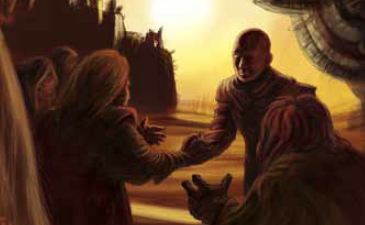
Handshakes are generally a good practice, but not enough to increase your Reputation on their own.
We've already seen a few ways Reputation can be decreased. Usually, any action that sets you apart as 'one of the bad ones' is liable to spark a scandal, even if it helped you get the job done. This also triggers a PR test in order to suppress the story, or take control of the tabloid narrative. It's modified in the same way as above, but each successful previous damage control test adds 1 to the difficulty. The public is fickle and loves a good scandal, your skills may be impressive but that's a law of nature. At the end of a session the GM tallies up the number of Reputation-altering items that got out to the people. If the ones in your favor outnumber the scandals your Reputation goes up by 1 and vice versa. The way Reputation events are used and their difficulties are also presented as another way to modulate the game's tone.
Contracts are the life of any Laser crew, and they come in a few varieties. The most common is a "hardclaused" contract which specifies a clear end goal you need to achieve to earn payment. This covers things like apprehending a fugitive, recovering stolen goods, making a delivery, and all that fun stuff. Contracts may be drawn up based on bad info, but that doesn't change the contract itself, it just means you'll either need to chat with whoever issued it or make a tough choice on your own. Contracts can also be more open ended, identifying a problem and empowering the Lasers to take "appropriate action". Any contracts with that clause are called "double-As".
Not every episode will start with landing a contract, sometimes trouble finds you. In that case, your investigations will likely lead you to a client willing to make it worth your while. A contract initiated by Lasers is known as a pickup contract, and they're generally used to hook into a personal arc and/or provide some variety in structure. The rules assume a payout for every job, so not finding a client is "gratuitously punitive" and landing one should be free of obstacles.
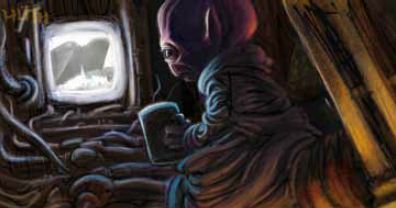
These guys have brains capable of understanding the greatest mysteries of time and space, but they still can't follow soap operas.
There's a lot of work out there for Lasers, but there's also a lot of ships looking to make a buck. Each new episode starts with a downtime test to see how long it's been since you got a call from Ossa Prime. It's a Business Affairs test with a difficulty modified by Reputation. The higher your reputation the more regular your work. The precise amount of downtime depends on the margin of your success or failure, and is measured in months. All upkeep costs are per month and have to be paid once you know how long you're floating jobless in space. Contracts pay out a standard fee which varies based on the number of players (X=24+6p where p=number of PCs) and can be modified with bonuses if the mission has additional, non-essential goals that the crew achieves.
Side deals are another way to score bigcreds. They're jobs someone offers outside the contract system, and always carry a risk of the GMs choosing. But they also have cash and who can say no to that. Half the time it's just hauling freight, but anything you can imagine someone hiring a licensed effectuator for is on the table. The payout for side deals is the same as a contract bonus, but the crew has a chance to haggle for more. The bonuses and deals available in a standard episode shouldn't exceed 3, with wiggle room for notably long or short episodes.
That usually makes for plenty of available cash, but crews can still fall short on their bills when things swing against them. Lasers can take out loans with a Business Affairs test modified by Reputation. Credit ratings in the Bleed are of the "He saved my cousin's life once" variety. The margin of success or failure determines the time you have to pay it off and how much interest will be charged. These aren't accredited Combine banks either, so expect regular checkups from shady folk with an odd fixation on your thumbs and a favor to ask.
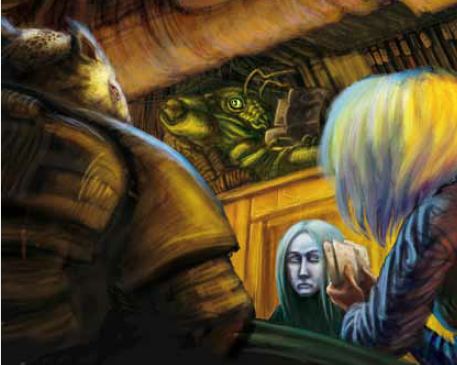
The tediousness of 'Go Space-Fish' is included in your ship's upkeep value.
The whole contract system is about upholding the law, so let's talk about the law now. Usually an episode will end with you slapping the cuffs on a guy and dropping him off somewhere, but there's material here for bringing the judicial system into your games when you want it. It's also handy info in case your PCs are brought up on charges for a crime they didn't commit. But really, what are the odds of that in a space opera adventure series?
First, it's good to remember that you're beholden to the laws of whoever hired you. The Laser program works most often with planets and peoples that recognize Combine law, but as we've seen the situation is always liable to get stickier than that. Jurisdiction can also complicate matters. The Combine claims all open space between Combine worlds, and the right to prosecute crimes committed on formerly-affiliated planets. Those claims are refuted by alien and autonomous planets. If they wanted to recognize Combine authority, they wouldn't be autonomous.
The court is familiar to anyone living in the 21st century in a country descended from English common law. Setting-supporting exceptions include truth-sensing devices monitoring testimony, jury selection involving Balla psychological tests, and jury deliberation having a Tavak meditation ceremony included.
Only extreme breakaway worlds and some aliens consider the death penalty. Many convicts spend a period of monitored probation and therapy, called Supervised Rehabilitation. On struggling worlds this boils down to house arrest. Combine prisons also have a rehabilitative focus, but imprisonment on autonomous worlds often has a focus on punishment. The Combine also contracts with privately-run penal colonies for their most dangerous offenders. As their biggest customer, Combine law has considerable sway over how they run their business, but they are not technically under Combine jurisdiction. Instead they work much like Lasers, trading on their reputations in order to score contracts with governments who need a place for their criminals to serve sentences. Some of them are even run by Lasers who went for a career change, and they'll know every trick you've got to spring the prisoner who has the information you need to crack the case and find your long-lost twin before horrible consequences befall... excuse me, I've fallen into adventure planning again.
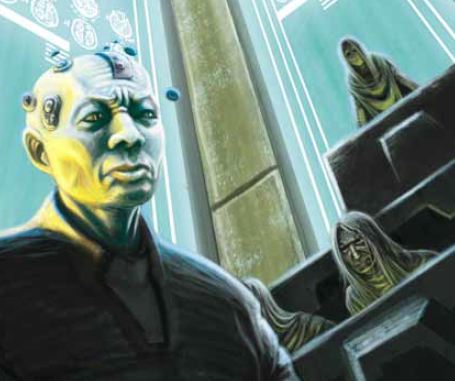
No explanation is given for why juries are filled with ghouls.
Next Time: Worldbuilding on a planetary scale.
Slartibartfast the Storyteller
Original SA post
ASHEN STARS
Website
pdf on DriveThru RPG
Part 14: Slartibartfast the storyteller
Now that we have the Bleed and the Combine sketched in generally, it falls to individual GMs to make the worlds that comprise them. This part gives guidelines to make that process efficient, painless, and fruitful. This is the first chapter that's more GM advice than anything, and that will hold true for the rest of the book. A campaign is meant to cover many mysteries on many varied worlds, so you're essentially making a new setting for each adventure. It keeps the game lively but it does make some assistance appreciated. Go planet:
Chapter 10: Worlds are Stories
The chapter begins with its central piece of advice: build the details from the premise. Ashen Stars is about investigating problems and finding solutions, not soaking in the milieu and generations of backstory. Worlds should have the details they need to make the session work, and those details should come from the premise of the episode at hand.
Step one is to determine the premise and the twist, and state them simply. Then give the world a placeholder name yo keep the premise in the foreground as you do the rest. One of the examples is a contract to rescue a shipment of slaves (premise) who don't want to be rescued (twist) in a place that's given the placeholder name Slaveworld.
Step two is to invent the supporting details that make the premise work and the twist believable. There could be many reasons people in the Bleed could accept slavery. Maybe they were taken form somewhere terrible, or are serving somewhere paradisical, or it's a tenet of their nufaith, or there are hostages involved. The book's Slaveworld scenario features symbiotic microbes that manipulate their hosts to migrate to new worlds and accept the slavery of their hosts as a suitable means of transport.
Step three is another layer of details to provide color and depth. This is also a good place to start weaving in personal arcs. Their Slaveworld example has a rapidly chilling climate which motivates the microbes' manipulations. That could have been triggered by a superweapon used in the war. The residents saw the ice age they triggered as an inspiration for their new commitment to pacifism, but the twist will reveal the real cause. The last step is to dump the working title and make up the one the players will know it by.
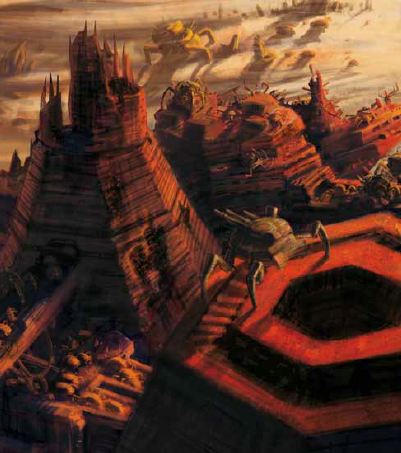
This is an illustration of the "Warworld" example, so maybe that's the one I should have summarized instead.
There's also a shorter guide for building a world then finding the mystery in it, a process more familiar to RPGs. Make up an environment that would be fun to explore, see if any central mysteries pop out, and think of a reason the Lasers might have to brave its most dangerous areas. It's suggested to look for inspiration in astronomy news, classic science fiction stories, and things like that. The steps are still premise -> supporting details -> extrapolated details, but you're mixing up the order.
There are two details every world should have, their habitation class and polity class. Habitation class is determined by population. Settled planets have over a billion people, Populated planets have less, and Outpost planets have less than 100,000 residents. Uncleared planets are those where colonization is not recommended. Living there is legal, but violates safety regulations and may constitute "Gray Market Pioneering", which is a fantastic turn of phrase. Uninhabited planets are anywhere without permanent residents, not to be confused with the uninhabitable.
Polity Class describes how the government works, and therefore what rights Lasers have and what rules constrain them. Alien worlds are inhabited by sentient races that have never been part of the Combine. Affiliated planets are Combine members and subject to its laws. Autonomous planets have seceded form the Combine and there are more of them all the time. They might have any sort of government you can think of, from authoritarian plutocracies to digicratic utopias. Mixed planets host several governments that each have their own relationships with the Combine proper. You can guess what Ungoverned means, so let's move on.
In case you don't have time for all that, there are a few pages of one-line hooks to get the creativity flowing. Here are some select favorites:
-Choked by fast-growing vegetation
-Culture formerly subject to Durugh occupation replicates its old caste system even more stringently than they ever did
-Deceased members of the elite are mummified and treated as if still alive
-Famous attraction: floating forests
-Genetic or cybernetic modifications considered obscene and must be veiled in public
-Intolerant utterances punishable by lengthy prison sentences
-Locals are immune to its carcinogenic atmosphere, but visitors aren’t
-Main industry: information retrieval
-One night here instantly cures the worst sleep disorders
-Otherwise pacific society uses capital punishment of scapegoats to relieve social pressure
-People install the brainwave patterns of dead loved ones in their household pets
-Psionic radiation makes visitors slightly and distressingly telepathic
-Social custom requires the first answer to any question to be a lie; then you may ask again and get the truth
-Supposedly destroyed during the Utopian era, this planet was found in another system at the end of the war
-Synthworld where genetically modified “vampires” prey on and dominate “flocks” of ordinary, consenting humans, according to the rules of an elaborate game
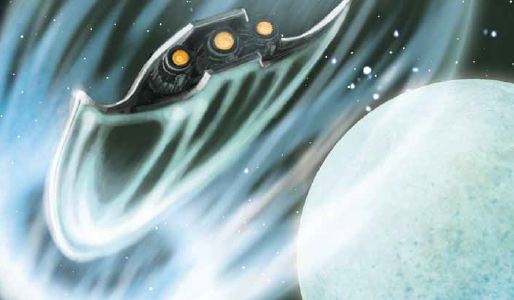
Translight engines were fist invested because they look cool, their FTL properties were discovered later.
Next is a bit of assistance in selecting names. Explorers and surveyors named the systems of the Bleed after mythological figures from Human, Balla, and Tavak history, but settled planets usually rename themselves. Not everyone wants their home to be named for a nymph. They suggest choosing names as reminders of home, celebrated figures, abstract concepts, or lyrical images. Synthworlds should always have a name suggestive of their theme.
Now that you have a bunch of planets, it's time to talk about moving between them. Stellar navigation is all about using translight engines to slip into translight corridors, little fissures of spatial instability that permeate the galaxy. Determining just what the corridors are and where they came from is an exciting matter for Combine physicists, but we aren't playing as physicists so let's skip it. We do know they're in constant motion and fluctuation, so trips are never identical and navigators must stay up to date. The corridors are also unstable, even more so since the Mohilar damaged them to cripple the war effort. Basically all this means that your journeys will, in general, take exactly as long as the plot needs them to and the GM can point to this page if anyone complains that it's too arbitrary and it takes them out of the setting.
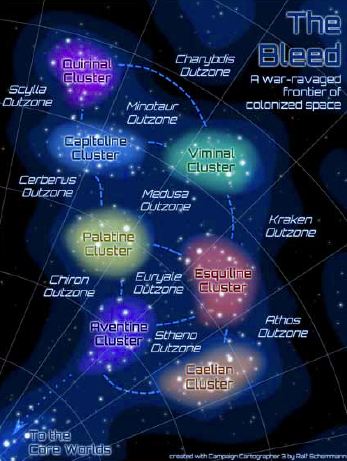
This map is of the various clusters of the Bleed. These maps are made based on how close together in approximate travel time worlds are, which is a function of the density of translight corridors. A map of their relationships in regular space would be wildly different and would not look like the same region of space at all. Clusters are defined by very dense networks of corridors making travel times short. Outzones lie between clusters and have relatively few corridors, slowing travel and making any worlds within remote, with all that entails for their economic issues and culture. There's a chart for approximate travel times, and players are free to test helm control to get somewhere in the minimum time. Players can also test Helm Control to get somewhere faster than another vessel when a race against time is in order.
Now we finally reach the title feature of the setting: The Ashen Stars Effect . Every once in a while sunspots appear over the entire surface of a sun and the sky seems to rapidly blink for a few seconds. All sorts of energy patterns are disrupted and strange occurrences can be triggered. The "renegade statistician Torus Ragan" has demonstrated a correlation between times of planetary crisis and the Ashen Stars effect, which is even stronger in cases where Lasers are performing survey actions or otherwise happen to be in the area. This is another example of the setting being a huge GM toolkit. The effect can be the focus of a storyarc, a license to handwave, or a signal that things are about to get weird.
Next Time: More aliens than a cantina scene
Bug Hunting
Original SA post
ASHEN STARS
Website
pdf on DriveThru RPG
Part 15: Bug Hunting
Every RPG book needs a bestiary, even the ones more about mystery than fighting. Every space opera needs action scenes, and those scenes need things for our grizzled heroes to punch and shoot. I really love the creatures presented in this chapter, even though the best ones don't really match up with the game's focus, tone, or themes as I see them. Game over man:
Chapter 11: The Bad, the Worse, and the Alien
Before we get to the good stuff, there are even more legal classifications for your Lasers to know. It's almost like being a real cop, except that when news gets out that you screwed up it actually impacts you. Sentients are intelligent beings capable of overcoming their biological imperatives, like you, me, the Tavak over there, and most all the aliens you'll meet. They have full rights and are subject to the justice system. "Lifeforms" refers to any organism incapable of higher cognitive function. They and their habitats are protected by environmental law, and hunting survives only under controlled ritual circumstances among the Tavak and Durugh.
Most of what we'll be covering today are Quasi-sentients: intelligent creatures that are still ruled by biological impulses. Since this is a chapter about monsters, the specific impulses are predatory and not very friendly. There are also benign quasis, but hey, monster chapter. Since rehabilitation is impossible, they are not subject to standard criminal justice but instead quarantined where they cannot reach sentient victims. These are not nice places and sure would be a hell of a place to crash land, I hope that doesn't happen to your crew! (please make that happen to your crew)
Some species get the additional designation " Class-K ". These are species that are so dangerous that any representative of Combine law is required to engage and destroy them wherever possible. This means Lasers. They are considered closer to a plague or a natural disaster than a species. Proper procedure is to confirm the sighting then determine your ability to do your duty. "As Lasers, you are expected to err on the side of sacrificing your own lives to stop them". Class-K species are meant to be kept back as a major enemy for season finale-type major events, but there are so many described that are all so cool I'd be tempted to use them all the time. It reminds me of the old D&D manuals that had pages and pages of magic items that you weren't supposed to hand out.
All the following are Class-K Quasi-Sentients unless noted otherwise:
Dermoids are a parasitic race of skin lesions that basically work like body snatchers. After the Dermoid covers a certain amount of a host's skin it develops a spike that plunges through the brain, gaining full motor control and access to the host's memories. Once a Dermoid colony gains enough control of a community they always try to exterminate Kch-Thk because their exoskeletons make them immune to infection, and those immune tend to figure out what's up and call the authorities. Several of the peoples made contact with Dermoids and survived before they discovered FTL technology, but at least 18 civilizations were completely destroyed by them.
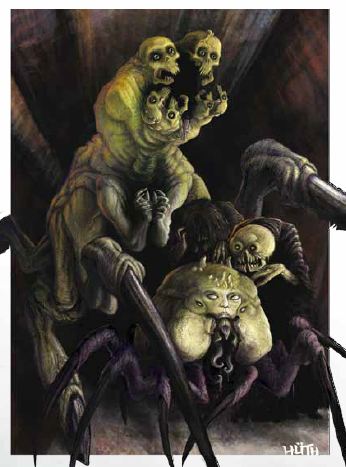
Note the spelling. Jagger actually looks worse than these guys this far in the future.
The Jaggar are a genetically designed species with a wide variety of body types. They live off stressed and terrified brainwaves, and set up elaborate torture dungeons to extract them from their victims. Jaggar queens are known to pride themselves on having the best and most stylish torture dungeons, and brag to one another about them. Just imagine being a fly on the wall in a Jaggar coffee shop. If you like shiny black leather and metal spikes and freaky torture these are the aliens for you, but I'm not sure this is the game for you.
The Klorn are a species of horrible murderbeats from the Tavak home planet. They have many stages of life, each one more capable of killing an entire crew than the last. Klorn are entirely without reason or thought and are classified as Lifeforms. The inspiration from the Alien films is obvious, but I like having the option to do that story in my game. One of their unique aspects is that in their juvenile stage a Klorn can set a DNA lock on someone and track them across the galaxy, and they generally use that to get revenge on whoever kills them in that stage. Of course, killing a Klorn only triggers its metamorphosis into a bigger, deadlier version. The End-klorn has a health pool of 52, and each successful hit in a scuffling test deals 12 extra damage. Please do not get in punching range of an End-klorn.
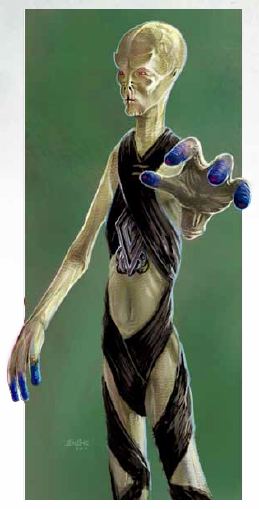
They look pretty good, considering their diet that is.
Lipovores are basically fat vampires. They aren't fat themselves, they just suck fat out of people until they die. Like vampires, they claim to be centuries or even millennia old and no amount of research has disproved it, and they also have a supreme disinterest in anything but feeding on people's fat cells until they die. Unlike vampires they don't really care about clan politics, theatrics, or the finer things in life. Lipovores will do whatever they can to escape captivity but have no stomach for fighting. They refuse to refer to any individual or group of sentient beings by any word but "food".
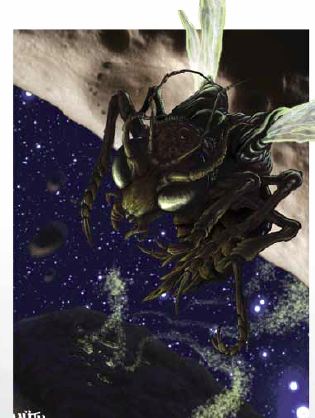
It's like someone saw The Unicorn and the Wasp and wanted to take revenge on Gareth Roberts via improvement.
Mynatids are a spacefaring race of two-meter long wasps, which should be all you really need to know. They predated on the Kch-Thk homeland since their prehistory. The Kch-Thk devil figure is a giant wasp, and anthropologists believe the consciousness migration ability started as a reaction to constant Mynatid attacks. Their swarms can blot out the sun and destroy all life on a planet in a matter of days. On seeing a Mynatid Kch-Thk supporting characters immediately freeze or flee. PCs must make a 4-point athletics spend to avoid the same.
Nanogons are a swarm of nanobots, sort of like microscopic Borg or a grey goo incident with creepy spider legs. They invade technological devices and rebuild them to their own specifications from the inside out. They become hypercharged engines of destruction bent on breeding as quickly as possible and exterminating biological life. They see their genocidal impulse as an act of self-defense, nanogon programming believes technology and organic life are incompatible and there ain't enough room in this galaxy for the both of us. The philosophical problem presented by Cybes drives them to extreme and sometimes self-defeating violence. Killing any cybe they find is the simplest way to overcome the computational dissonance that bio-organic integration inspires. Some evidence suggests Nanogons originated in the future, so there's a time loop plot waiting to happen.
The Phyllax are the closest the book gets to a traditional zombie plague, except they're plants. Phyllax root themselves in any animal, but bipedal humaniods are their favorite for being so versatile. The vines communicate via subtle bioelectric impulses that are efficient enough to appear to be a hivemind. They are capable of making intelligent, coordinated plans to reach their goals and take into account a wide variety of stimuli to do so. They are even able to study technology and reverse-engineer the effects using their biomass. Phyllax seedships sail the lonely space between worlds looking for opportune moments to propagate their kind.
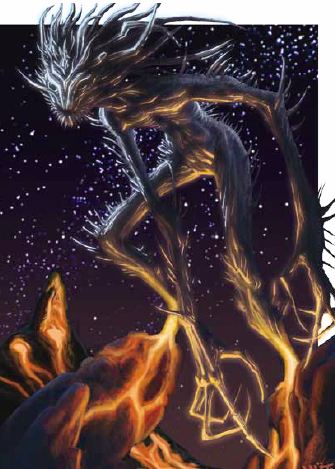
Pointy=Scary ???
The Sh'ard are big ugly monsters and my least favorite Class-K species, even the name is dumb. I guess every setting needs one though. A rogue Vas Kra named D'Jellar had a rivalry with Combine captain Duto Swain and one of their encounters opened a logic rift now known as the D'Jellar Anomaly. Sh'ard are created whenever the anomaly intersects with a volcanic planet. The Vas Kra used to keep that from happening, but they aren't around anymore. Now, every once in a while, 4 ton spiky metal men pop up out of the ground to stab people just because they like to. They are all identical crystalline beings whose only identifying features are damage taken after formation.
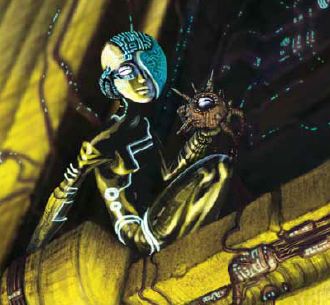
80% Cyber, 40% punk, -20% hair
That's a whole lot of words, art, and effort for things you generally aren't supposed to have in your game. The rest of the chapter covers the antagonists you'll run into much more often. Wild animals take up almost a page, and there are five pages for any sort of neer-do-well, thug, and extremist the Bleed can offer up. It's all good stuff, but the entries are made with an eye toward reshaping and personalization so there isn't much depth there, no matter how useful the entries are. I won't be covering the index either for the same reason. The standard enemies also include at least one for each of the peoples with a fitting reason for why they're making trouble and getting in fights, like this Vas Mal who went nuts from having a brain that's too small:
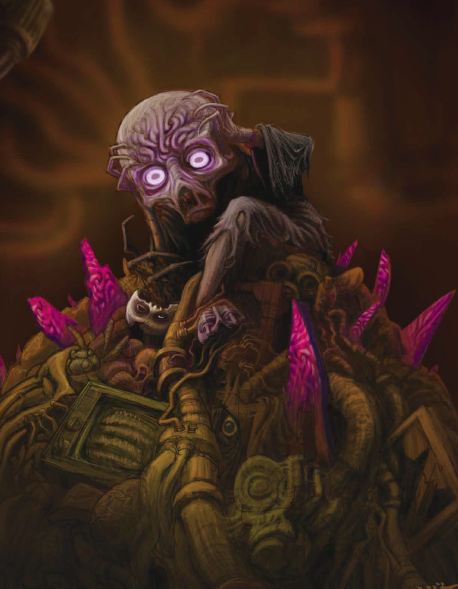
Next time: Game Runner
Running the Bleed
Original SA post
Sorry for the long break, I've been busy with a lot of other projects,
some TG-related
but mostly about my wedding. Time to get back in the space-saddle.

ASHEN STARS
Website
pdf on DriveThru RPG
Part 16:
Now that we have all the tools we need to run an adventure, it's time to learn about how. Players must feel so special having all their stuff front-loaded in books while GMs are always stuck in the back. It ain't fair I tell ya! This chapter is all about building adventures for your Lasers to enjoy and mysteries for them to solve. It also sort of doubles as advice for amateur fiction writers looking to emulate the same genres as the game. Elementary, my dear Kch-Thk!
Chapter 12: Running the Bleed
There are two major ways presented to build an Ashen Stars adventure and the difference is the amount of prep done before getting to the table. We'll start with 'lots'. Creating a mystery starts just like building a planet: set a premise and a dramatic twist. Then, fill them in with backstory in broad detail and determine whether the crew will start with a contract or stumble into trouble. Next comes complications, the specific opposition the Lasers face. This can range from concrete villains to abstract pressures that get in the way of victory. Tangential opponents (rivals, red herrings, wild animal attacks) can also give interesting complications to an episode.
Consult the personal arcs and connect one or two to the adventure. Your premise may already be based on one, but no adventure should go without featuring a personal arc as a b-story at least. At some point there should also be a clear choice that needs to be made between altruism and self-interest. Not everything needs to be a major moral quandary, a quick threat to Reputation will do, but it should still be present. If you do want a big one, exploiting friction between two PC's drives is a handy tool.
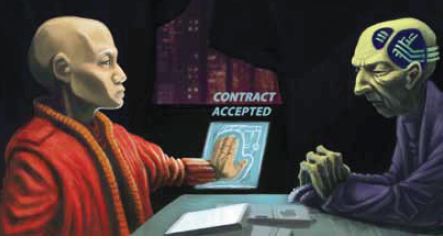
"Stick with me and I'll make you a star, kid" (he actually became a Starkid)
That covers the elements of the episode, now you have to arrange them into scenes. The intro scene is just what it sounds like, and you use it to get the players up to speed on all they need to know to start with. Core scenes are those that contain a core clue. These are important, because core clues are the information they'll need to solve the mystery. They should also point to where to find more clues, but you don't want them to be a hard sequence. Avoiding that advice is how GUMSHOE can become the railroad people are afraid it is.
Alternate scenes provide other information that can help propel the plot, but aren't necessary. They're more about context and additional detail. They don't have to lead to another clue if you don't want them to. Antagonist reaction scenes are when the complications strike back and attempt to impede the heroes' progress. Hazard scenes are like that, but with impersonal complications. Sub-plot scenes cover any progression not directly tied to the investigation, usually relating to someone's personal arc, a side deal, or a character just poking around the planet. The Concluison scene is the end of the investigation, and generally includes some major obstacle/action scene/final dilemma. There's also four pages of sample premises to build from that read like an episode guide to the best Trek spinoff that never existed.
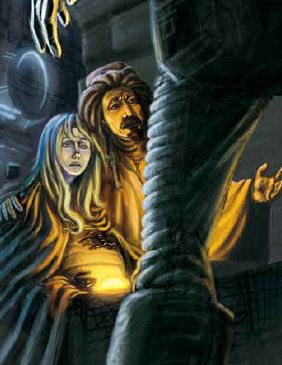
In this sample premise, a man argues for his right to insert glow worms in homeless people's abdomens.
The second way to make episodes is on the fly. Think up a premise and a bit of backstory, then let your crew go nuts and try to keep up. I don't know if I'd recommend this, the whole section spends more time saying it's possible than that it's a good idea. There is good advice here though: react to input, never negate, push players forward when they lack a clear direction, deliver what your players want out of the experience, all that stuff. Robin Laws wrote the book, it's good advice to keep in mind no matter how you structure your game.
Your players may want (or expect) their episodic adventures to build into a series arc. There are a few setting points that lend themselves to that sort of story, notably the Bogey Conundrum and any of the Class-K aliens. Arcs should play out over several episodes, going from foreshadowing to a major Bleed-shaking event. Series and Personal Arcs can both bring in recurring characters. Rivals and enemies are pretty common choices, but an abiding emotional bond between PC and NPC is what defines a good recurring character, not their role.
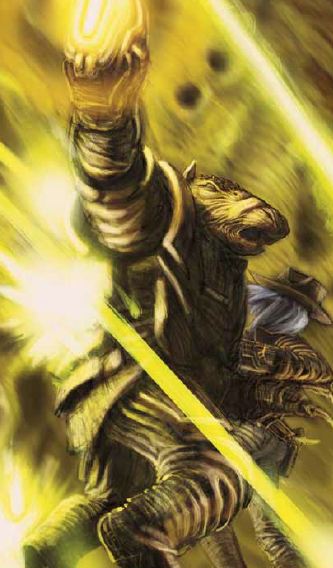
I guess this is all right, but all the cool GMs end their episodes with a bald man giving a lecture on ethics.
Then the chapter moves into general GUMSHOE tips. First, a good session is one that balances the structure needed for an investigation and the freewheeling most players get into. The perception of railroading is harder to shake than the reality; in playtesting the groups most worried about railroading were actually those whose GMs did the most improvising. Any track may be the right track, treat your prep as a blueprint, the episode as played is the final product. Don't be afraid to cut to a new scene if the current one begins to drag and the important info has already been gleaned from it. Don't be afraid of pop culture references. They're going to be made so you might as well embrace them as a common shorthand.
The chapter ends with a quick example of play, but that can be skipped over because we'll be doing our own here in this thread in the coming weeks. That's right, all that's left of interest in the book is the sample adventure. Getting this update out now is somewhat bad timing because I won't be able to start that until next week, but be warned: there will be audience participation. (also feel free to shoot out quick character concepts in the mean time, even though I might miss them since this thread is about three-dozen games at once)
Next time: recruitment opens.
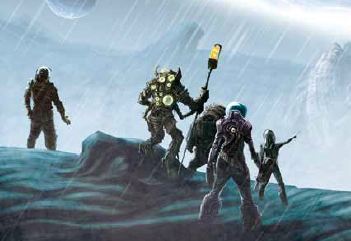
These guys are really excited for the sample adventure and hope they manage to get in it.